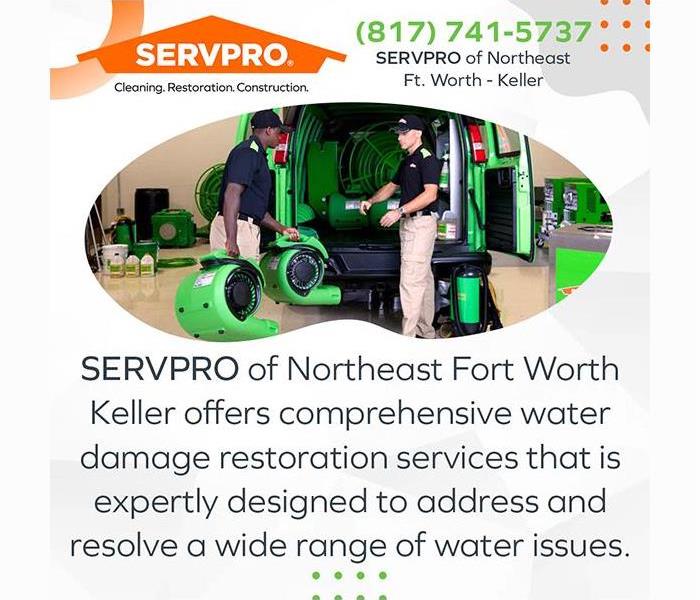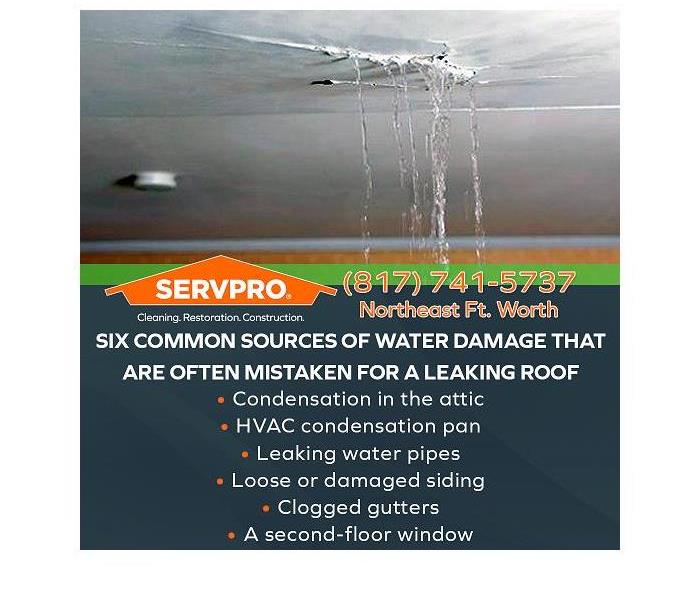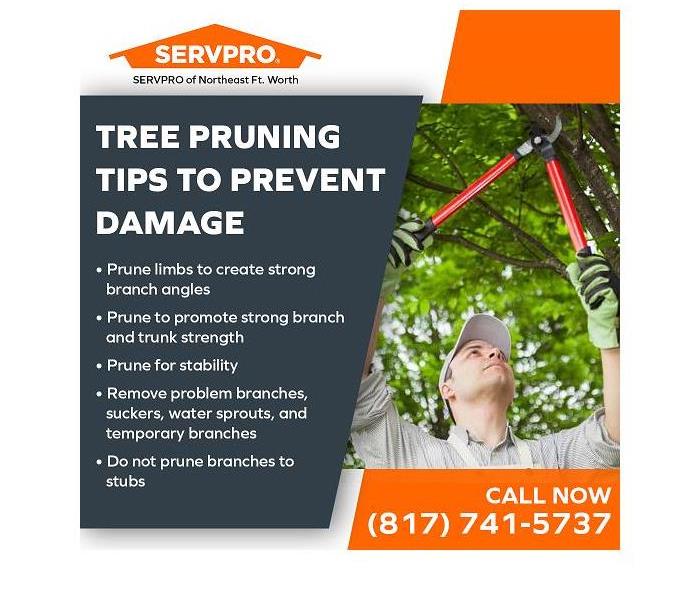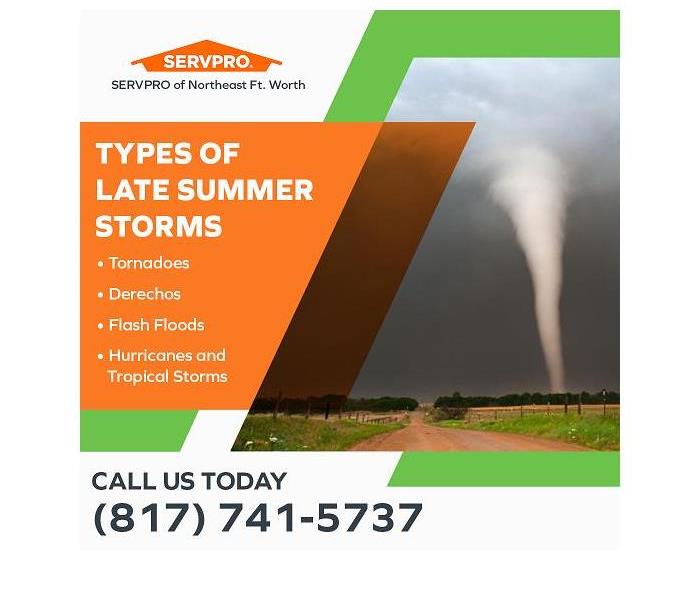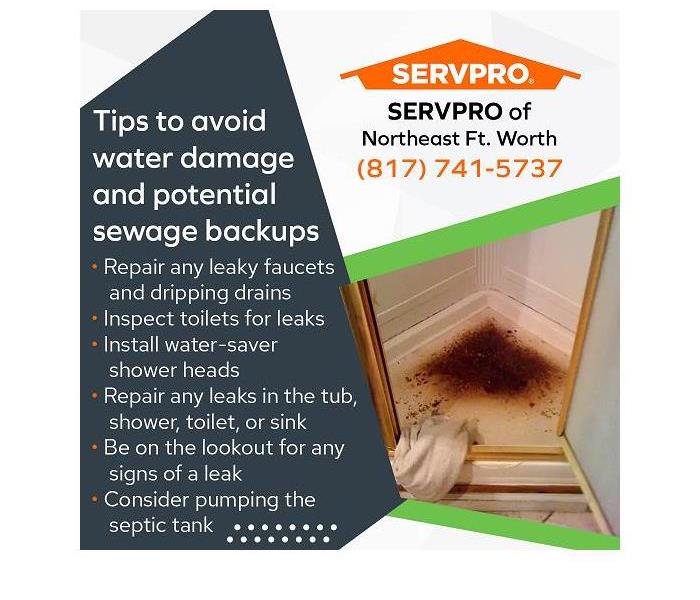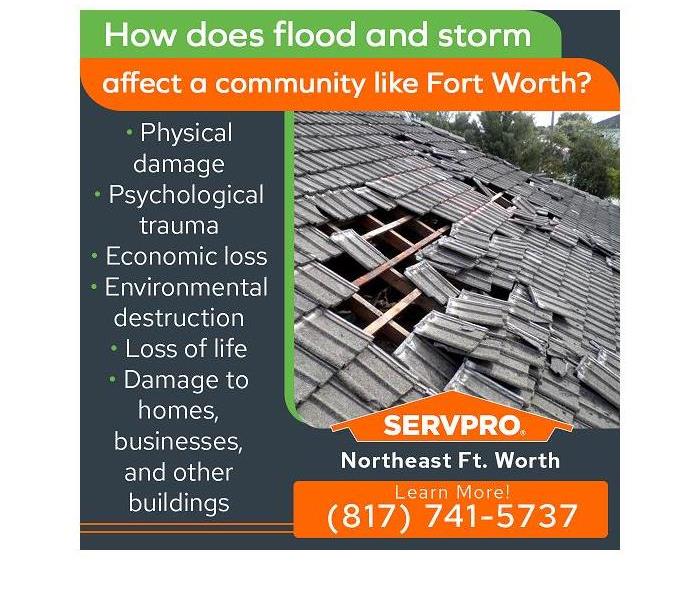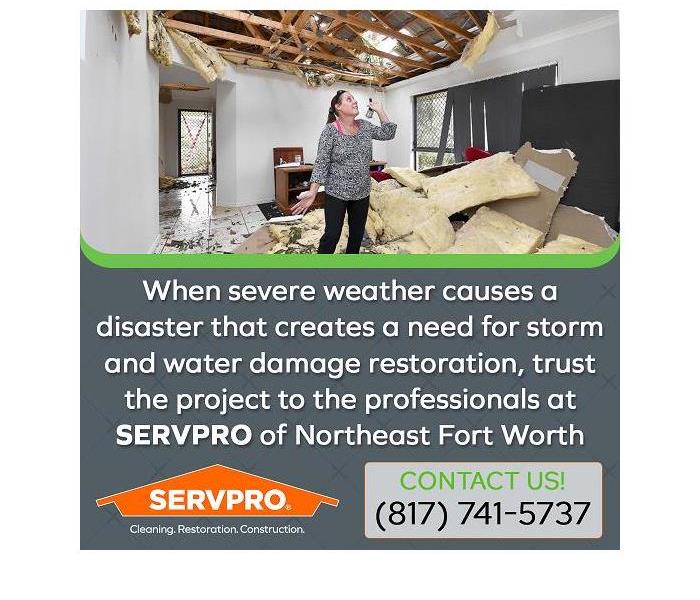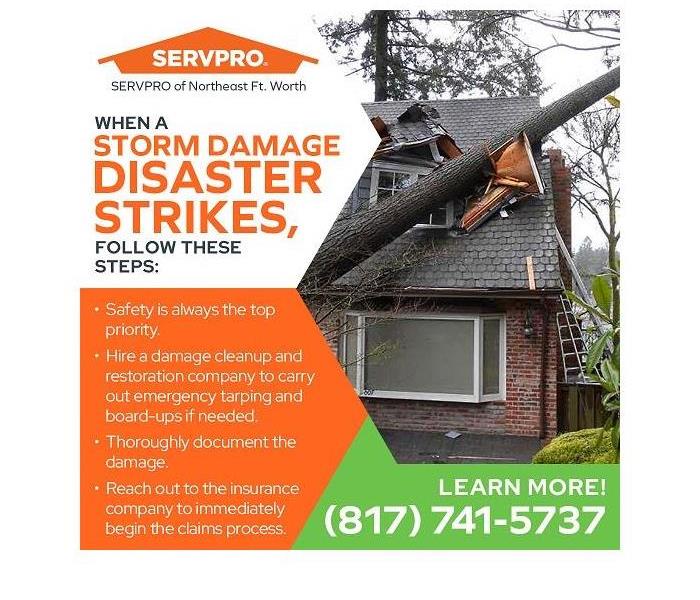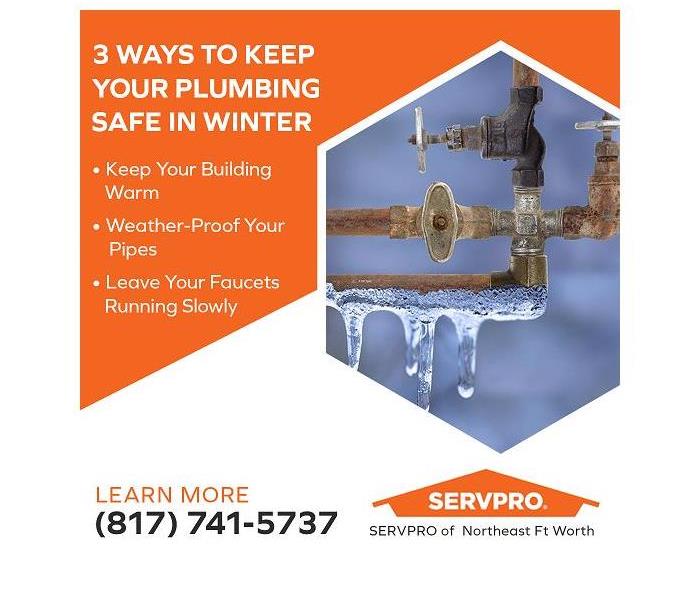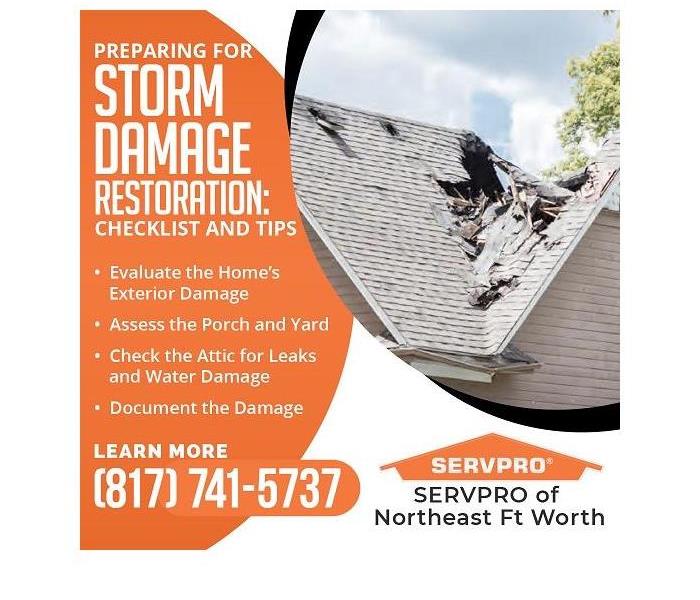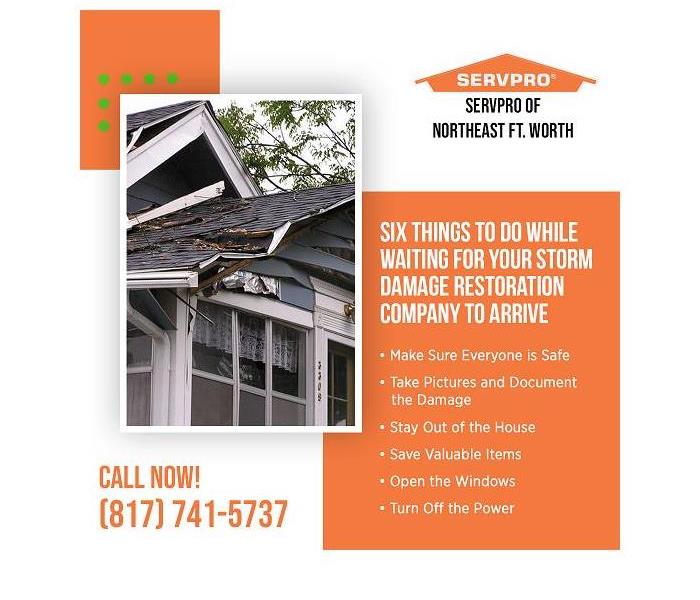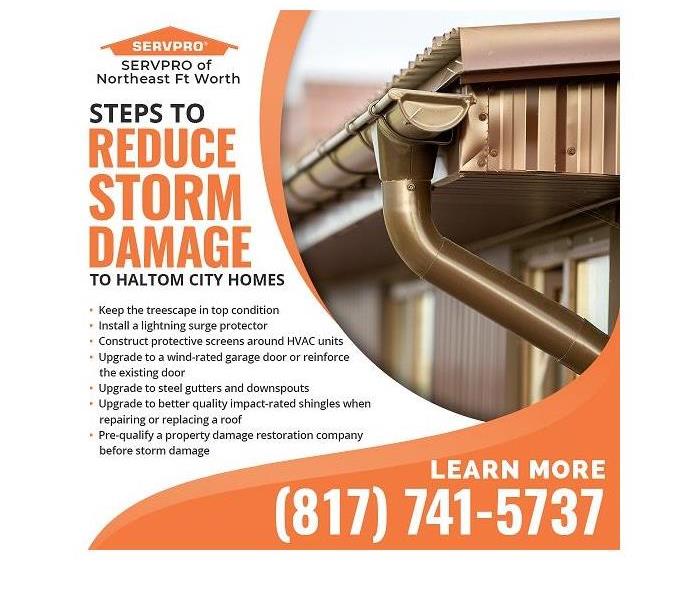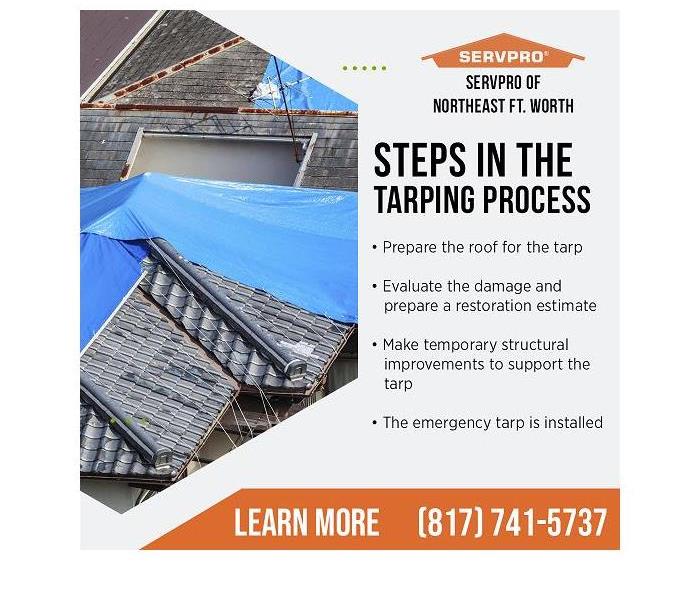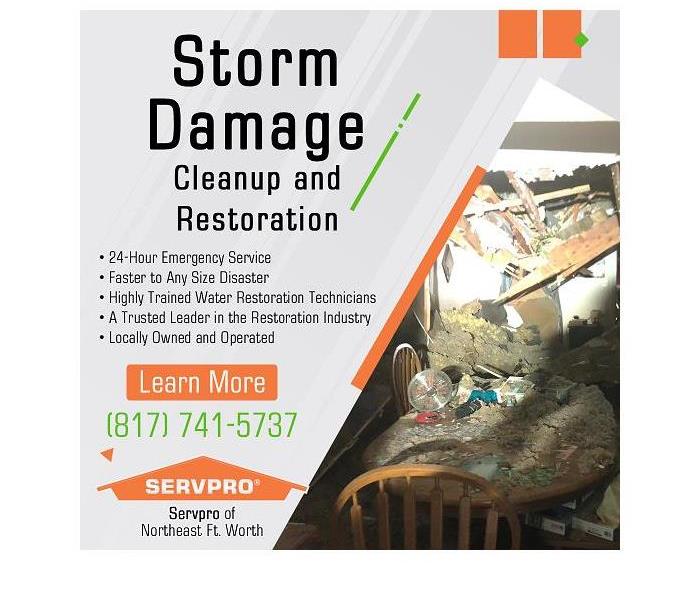Archived Storm Damage Blog Posts
Preparing for winter storm power outages and storm damage in Old Town Keller
12/22/2023 (Permalink)
Key takeaways:
- Essential steps to prepare for winter storms and power outages.
- How to minimize and address storm damage effectively.
- SERVPRO's expert services for water removal and damage restoration.
Winter storms can profoundly impact communities like Old Town Keller. It is essential to understand the potential consequences these storms can bring. The significant challenges are power outages that leave residents without heat and light and the risk of water damage due to heavy snowfall and ice melt. At SERVPRO® of Northeast Fort Worth, we've seen firsthand how these winter storms can affect homes and businesses. This section of our blog aims to delve into the common issues faced during these storms, helping our community prepare better and mitigate the risks associated with these seasonal challenges. By understanding the impact, residents can take proactive steps to safeguard their properties and well-being against the harsh realities of winter in Old Town Keller. We at SERVPRO of Northeast Fort Worth, Keller, also assist with storm damage with our water removal services in Old Town Keller.
Common challenges faced during winter storms
- Frequent power outages: Winter storms often lead to power outages due to heavy snow and ice accumulation on power lines and trees. These outages can last several hours or even days, leaving residents without essential utilities like heating and electricity.
- Property damage from snow and ice: The weight of snow and ice can cause significant damage to roofs, gutters, and windows. Ice dams can form, water seeping into homes, while frozen pipes can burst, causing indoor flooding.
- Impaired road conditions: Heavy snowfall and icy roads make travel hazardous. This affects daily commutes and can delay emergency services and repairs, leaving residents vulnerable during critical times.
- Health and safety risks: Cold temperatures and lack of heating can pose serious health risks, especially for vulnerable populations. Additionally, alternative heating sources like generators or candles increase the risk of fire or carbon monoxide poisoning.
- Communication challenges: Winter storms can disrupt cell phone and internet services, making it difficult to communicate with family or emergency services, further exacerbating the challenges during a storm.
The importance of being prepared
- Minimizing potential damage: By preparing in advance, homeowners can reinforce their properties against damage. Simple actions like insulating pipes, clearing gutters, and securing loose outdoor items can significantly reduce the risk of storm-related damage.
- Ensuring personal safety: A well-thought-out plan and emergency kit can be life-saving during a storm. This includes having supplies like non-perishable food, water, blankets, and a first-aid kit, ensuring safety and comfort during prolonged power outages.
- Reducing stress and anxiety: Preparation can alleviate the stress and uncertainty of winter storms. Knowing you have a plan and the necessary supplies provides peace of mind, allowing you to focus on staying safe rather than scrambling for resources at the last minute.
- Facilitating faster recovery: Post-storm recovery can be smoother and quicker if prepared. Having the right tools and plans in place means you can start the cleanup and repair process immediately, minimizing the long-term impact on your home and life.
Essential preparation steps for winter storms
Preparing for storms becomes a top priority as winter approaches, especially in areas like Old Town Keller, where the weather can be unpredictable and severe. Taking proactive steps to prepare your home and family for winter storms is crucial for minimizing damage and ensuring safety. This part of our blog focuses on essential preparation steps to help you confidently navigate the challenges of winter storms. By understanding and implementing these measures, you can protect your property, maintain essential services during power outages, and provide a safe environment for your loved ones during these harsh winter months.
Securing your home against storm damage
- Inspect and reinforce roofing: Check your roof for damages and make necessary repairs. Reinforce it to withstand the heavy weight of snow and ice.
- Clear gutters and downspouts: Ensure that gutters and downspouts are clear of debris to prevent ice dams and water buildup, which can lead to water damage.
- Trim tree branches: Trim branches close to your home to prevent them from breaking under the weight of snow and ice and causing damage.
- Seal windows and doors: Check for and seal any gaps in windows and doors to prevent cold air and moisture from entering your home.
- Insulate pipes: Properly insulate pipes, especially those in unheated areas like basements and crawl spaces, to prevent them from freezing and bursting.
Preparing for power outages
- Maintain an emergency kit: Keep a well-stocked emergency kit with essentials like batteries, flashlights, a first-aid kit, and non-perishable food items.
- Invest in alternative heating sources: Have alternative heating sources like wood-burning stoves or propane heaters, and ensure they are well-maintained and used safely.
- Charge electronic devices: Before the storm, fully charge cell phones, laptops, and other electronic devices for communication and entertainment during outages.
- Plan for water supply: Store sufficient water for drinking and sanitation, as a power outage can affect your home's water supply, especially if you rely on a well.
- Stay informed: Have a battery-powered or hand-crank radio to receive weather updates and important information from local authorities during the storm.
Immediate actions during a winter storm
When a winter storm hits, the situation can escalate quickly, making it crucial to know the immediate actions to take. This section guides you through essential steps to ensure safety and minimize damage as the storm unfolds. Quick and informed actions can make a significant difference in coping with a power outage or addressing water intrusion. Understanding these steps is key to navigating the storm effectively, keeping your family safe, and protecting your property from severe damage.
Staying safe and warm
- Use alternative heat sources safely: If you have a fireplace, wood stove, or portable heater, use it safely to maintain warmth. Ensure proper ventilation to avoid carbon monoxide buildup.
- Dress in layers: Wear multiple layers of clothing, including hats and gloves, to retain body heat. Utilize blankets and sleeping bags to stay warm.
- Seal off unused rooms: Close off unneeded rooms to concentrate heat in occupied areas of your home. Use draft stoppers or towels under doors to keep the warm air in and the cold air out.
- Prevent pipes from freezing: Allow faucets to drip slightly to keep water flowing and prevent pipes from freezing. Open cabinet doors under sinks to allow warmer air to circulate the plumbing.
Monitoring and managing potential water intrusion
- Inspect your home regularly: During the storm, periodically check your basement and crawl spaces for signs of water intrusion. Early detection is crucial to prevent extensive damage.
- Use sandbags and water barriers: If you anticipate flooding, use sandbags around your property's perimeter, especially near doors and low-lying areas, to redirect water away from your home.
- Clear snow from critical areas: Regularly remove snow around your home's foundation, windows, and doors. Pay special attention to areas where melting snow could enter your home.
- Have a water removal plan: In case of water ingress, have a plan for water removal. This could include having a sump pump ready or knowing whom to call for professional water removal services, like SERVPRO of Northeast Fort Worth Keller.
Post-storm response and recovery
As the storm subsides, the focus shifts to post-storm response and recovery, a critical phase in managing the aftermath of severe winter weather. This part of our blog outlines the crucial steps to take once the immediate threat has passed. From assessing and documenting the damage for insurance claims to initiating the cleanup and restoration process, these actions are vital in returning your life and property to normalcy. Understanding the right approach to post-storm recovery can significantly expedite the process and ensure thorough and effective water damage restoration, especially with the help of experienced professionals like SERVPRO of Northeast Fort Worth.
Assessing and documenting damage
- Conduct a thorough inspection: Inspect your property carefully for any signs of damage once it's safe. Look for structural damage, water intrusion, broken pipes, and damaged roofs.
- Take photos and videos: Document all damages with clear photos and videos. This visual evidence is crucial for insurance claims and can provide a detailed record of the extent of the damage.
- List damaged items: Make a comprehensive list of damaged personal property. Include descriptions, the date of purchase, and approximate value, if possible.
- Contact your insurance company: Report the damage to your insurance company immediately. Provide them with your documentation to start the claims process.
Initiating cleanup and restoration
- Prioritize safety in cleanup: Ensure that the property is safe to enter. Be cautious of hazards like electrical issues, gas leaks, and structural damage.
- Remove debris and water: Begin the cleanup process by removing debris and standing water. This helps prevent further damage and mold growth.
- Dry and dehumidify the area: Use fans, dehumidifiers, and heaters to dry out wet areas. Proper drying is essential to prevent mold and mildew.
- Contact SERVPRO for professional help: Contact SERVPRO of Northeast Fort Worth, Keller, for extensive damage. Our team specializes in water damage restoration, offering comprehensive services to handle water removal, drying, cleaning, and restoring your property to its pre-storm condition.
SERVPRO of Northeast Fort Worth’s role in storm damage recovery
Rapid response to emergencies:
- Immediate reaction to calls for help after a storm.
- Quick action to prevent further damage and initiate the recovery process.
Thorough damage assessment:
- Detailed inspection of water intrusion, structural damage, and potential mold risks.
- Strategic planning is based on the specific needs of each property.
Advanced water removal techniques:
- Utilization of state-of-the-art pumps and dehumidifiers.
- Efficient extraction of water and moisture to prevent further damage.
Comprehensive property restoration:
- Inclusive services covering drying, cleaning, and sanitizing affected areas.
- Tailored restoration to return each property to its preloss condition.
- Repairing structural damage and restoring damaged items.
Mold prevention and treatment:
- Addressing mold growth issues that might have arisen due to moisture.
Assistance with insurance claims:
- Providing documentation of damage and restoration work.
- Helping clients navigate the insurance claims process smoothly.
Commitment to client satisfaction:
- Ensuring minimal stress and disruption for clients.
- Prioritizing a return to normalcy and peace of mind post-storm.
Community focus:
- Dedicated to supporting and restoring the Old Town Keller community and surrounding areas.
- Understanding the local impact and specific challenges of winter storms in the region.
SERVPRO of Northeast Fort Worth’s approach to storm damage recovery is rooted in swift, professional water cleanup service, ensuring effective restoration and support for the community during challenging times.
Staying prepared and partnering with SERVPRO of Northeast Fort Worth
Staying prepared for winter storms is crucial, particularly in areas like Old Town Keller that experience severe weather. You can safeguard your home and ensure your family's safety by taking proactive steps. However, should you face the unfortunate event of storm damage, know that you're not alone. Partnering with SERVPRO of Northeast Fort Worth, Keller, provides you with an ally skilled in navigating the aftermath of storms. Our expertise in water damage restoration and water cleanup services ensures your property is restored efficiently and effectively. Trust in SERVPRO to be your steadfast partner in weathering any storm and restoring normalcy to your life. Contact us today at (817) 741-5737 to learn more about us.
Six common causes of water damage often mistaken for a roof leak
3/29/2023 (Permalink)
Blog Summary: When water damage appears on the ceiling or in the attic, the homeowner might assume that the cause is a roof leak. However, the water intrusion could originate from a different source.
SERVPRO® of Northeast Fort Worth provides flood restoration services when storm damage or water damage occurs. Powerful pumps, wet-dry vacuums, heavy-duty dehumidifiers, and rapid spin fans quickly remove water and excess moisture. Advanced moisture-detecting technology ensures the efforts are successful. Advanced cleaning techniques and EPA-approved products are used to clean, disinfect, sanitize, and deodorize the flood-damaged home or business.
A green, brown, or black stain on a sagging, water-logged ceiling may not be a roof leak. Other water sources in the attic or above the ceiling may be the culprit. The diagnosis of the source of the water may be challenging, especially since water can travel a long distance over support timbers, an attic floor, and through the ceiling. Below are six common water damage sources that are often mistaken for a leaking roof.
1. Condensation in the attic
Proper insulation and adequate ventilation are essential for the overall health of the attic. Inadequate insulation and insufficient ventilation allow moisture to accumulate and become trapped in the attic. The moisture will eventually condense, moistening structural timbers, flooring, boxes, clothing, furniture, documents, and other valuables in the attic. An accurate assessment of the situation will require the services of a competent professional. Be sure to operate bathroom and kitchen fans when bathing or cooking to reduce moisture in the home. Make sure all ventilation fans distribute 100% of the moist air to the house’s exterior.
2. HVAC condensation pan
Some homes have part of the HVAC system located in the attic. The evaporator has a condensate pan to catch condensation and exhaust the water to the home's exterior through the condensate pan drain. Over time, the condensate pan may crack and begin to leak. Older condensate pans are made of metal and can develop leaks due to rust, while plastic pans can develop cracks. Sludge and slime can build up and block the drain or clog the pipe evacuating the pan outside the home. Occasionally, a mouse, lizard, or snake could crawl up the drain and clog the system.
An HVAC condensate pan leak can reveal itself in many ways, including the following:
- Brown, green, tan, or black stains appear on the ceiling below the inside unit.
- The ceiling warps, sags, or eventually collapses.
- Affected baseboards swell.
- Paint bubbles and peels.
- Wallpaper separates from the wall.
- A moldy, musty smell is present in the attic and the rest of the home.
On a hot, humid summer day in Blue Mound, TX, an HVAC system can generate about 20 gallons of water. That amount of water in the attic and dispersing through the house can cause serious water damage, especially if no one is home to notice the overflow. To help prevent issues, the homeowner should have a reputable, licensed HVAC professional inspect the entire HVAC system annually to identify any potential or existing issues and make necessary repairs.
3. Leaking water pipes
Plumbing pipes in a two-story home or the attic may develop slow pinhole leaks or collect condensation. The small leaks may mimic a roof leak. Stains on the ceiling, swelling baseboards, and crown molding only indicate a leak but not the source of the leak. A plumber or roofing contractor can inspect the attic and locate the leak source.
4. Loose or damaged siding
Heavy rains accompanied by high winds can penetrate behind the siding. Gaps around windows, punctures and cracks in the siding can allow water to get behind the siding and cause water damage. Mold, mildew, wood rot, and insect infestations can result. The leaks might appear to originate in the roof, but the entry points are related to the siding. Gaps, missing caulk, cracks, and punctures must be identified and repaired. Any mold and rot issues need to be mitigated or repaired.
5. Clogged gutters
Clogged gutters can be the source of water damage around the foundation, behind siding, around windows, and in the attic. When these structures are blocked, the structural integrity of the foundation could be compromised, and the basement could flood. Visually inspect the gutters several times a year. If the tree canopy encroaches on the roof space, check the gutters after every heavy thunderstorm to avoid water damage to the home.
6. A second-floor window
If a house has a second story or a bonus room over the garage, some homeowners will open a window to allow heat to escape the upper part of the home. However, rainwater can blow in and cause wood to rot around the window and beneath the seal, extending to the floor. Hardwood floors, carpeting, and the substrate, can also sustain water damage. Even if the window is kept closed, a pane could be broken or cracked, allowing for a water intrusion during rainy weather. Avoid opening windows to ventilate the second-story or bonus room above the garage, and immediately repair any broken panes or damage around the windows.
In case of water and flood damage, contact the team at SERVPRO of Northeast Fort Worth for immediate results. An IICRC-certified team of property damage restoration professionals can be on the scene in about an hour, 24/7, 365 days a year, including holidays.
For more information about flood damage restoration, contact the SERVPRO of Northeast Fort Worth at (817) 741-5737. The office can also be reached by emailing office@SERVPROnortheastftworth.com.
A Ten-Year Review: Unforgettable Weather and Storm Damage Occurrences in the Local Area
2/14/2023 (Permalink)
Blog Summary: SERVPRO® of Northeast Fort Worth reviews extreme weather conditions in the Dallas-Fort Worth metropolitan area over a ten-year period from 2010 to 2020.
SERVPRO of Northeast Fort Worth is available 24/7, 365 days a year, including on those days when the weather has caused a significant storm and flood damage requiring flood restoration services. North Texas experiences a wide range of weather during the year. The normally calm winds, sunny North Texas sky, moderate temperatures, and average precipitation are occasionally interrupted by roaring tornadoes, oppressive 100-degree heat, violent thunderstorms, long periods of drought, and a rare blast of frigid temperatures and snow. Neighborhoods like Scenic Bluff, Fort Worth, TX, are no strangers to periods of wild weather. Below is a survey of eight disruptive and destructive weather events between 2010 and 2020.
#1. February 11-12, 2010: A foot of snow in 24 hours
Abundant moisture from a low-pressure system over North Texas and temperatures that barely crawled above freezing resulted in over a foot of snow in less than a 24-hour period in North Dallas.
#2. February 3-4, 2011: Another major snowstorm hits North Texas
Nearly a year later to the day, another blizzard blanketed the metro area, this time with five inches of snow. School closures, flight cancellations, and a near miss of Super Bowl XLV. A sheet of sleet laid down just before the snow made for treacherous conditions, as whatever snow melted during the daytime refroze in the evening.
#3. Summer 2011: The longest heat streak
This heat streak was just 3 days shy of Ken Jennings’ 74-day winning streak on Jeopardy. North Texas did not receive any cash prizes for the streak, but the utility companies enjoyed a hefty payday. For 71 sweltering days, the temperature climbed above 100 degrees or higher, over three times higher than the usual average. During that time, fifty-five days saw nighttime temperatures stay above 80 degrees.
#4. 2015: The wettest year on record
In 2015, Dallas-Fort Worth flirted with becoming a tropical paradise with 62.61 inches of rain, nearly double the average annual rainfall. May alone recorded almost 17 inches of rain.
#5. December 26, 2015: Turbulent tornadoes tear through North Texas
A tornado is no respecter of seasons and can strike any day of the year if conditions are right. Five days into winter and just one day after Christmas, a dozen twisters ripped a path of destruction through North Texas. The strongest tornado, an EF-4 with 180mph winds, mowed through Garland, Rowlett, and Sunnyvale. Thirteen people lost their lives. Two thousand homes were destroyed.
#6. Fall 2018: The wettest fall on record
Between September and November, Dallas-Fort Worth recorded 29.21 inches of rain, just 7 inches shy of the annual average rainfall. On September 21 and September 22, 8.11 inches of rain fell on the area, the third-most ever in a 24-hour period.
#7. June 9, 2019: Windstorm blows through Dallas
On June 9, a line of thunderstorms generated damaging winds in excess of 70 mph. Hundreds of large trees were toppled, leaving more than 200,000 people without power.
#8. October 20, 2019: An EF-3 tornado blasts Dallas
Eleven tornadoes cut a deadly and destructive swathe through the region that October evening. An EF-3 twister bulldozed a 15-mile path of damage from northwest Dallas to Richardson. Though hundreds of homes were damaged, no lives were lost.
Severe weather events have continued into the 2020s, with the coldest day recorded in 72 years: February 16, 2021. On this day, the thermometer dropped to -2 degrees Fahrenheit and hovered at record-cold temperatures for several days. Thousands of homes suffered water damage from frozen pipes. The power grid collapsed, leaving hundreds of thousands of Texans without electricity. Tragically, many people lost their lives in the brutal cold snap.
What to do when weather-related property damage occurs
Preparation is the key to weathering bad weather. Prepare in advance by putting together an emergency response. A disaster-ready plan ensures that when the power grid collapses, shingles fly off, a tree makes an unexpected entrance through the roof, or flood waters snake their way into the home; everyone knows what to do and who to call for help.
The plan should include the following:
- Supplies: LED flashlights, batteries, weather radios (2), food, water, toiletries, hygiene products, first-aid kits, walkie-talkies, emergency mylar blankets, rain gear, hats, work gloves, zip ties, heavy-duty garbage bags, nitrile gloves, etc.
- Evacuation and meet-up instructions
- Contact information for family members, friends, and neighbors
- Contact information for service providers (HVAC, plumbing, tree service, roofing contractor, electrician, and property damage cleanup and restoration company)
The team at SERVPRO of Northeast Fort Worth urges homeowners and businesses to pre-qualify dedicated service providers so that when disaster strikes, the response involves only one call to a vetted, trusted plumber, contractor, or restoration company.
The pre-qualification process is vitally important when needing services for storm damage, flood damage, fire damage, smoke damage, or water damage disaster. Rapid response and quick cleanup process are crucial to prevent advanced secondary damage to the disaster scene. Mold can begin in as little as twenty-four to forty-eight hours. Carpeting is typically unsalvageable after one to two days. If carpets and rugs are not immediately dried, cleaned, and disinfected, replacement may be the only option. When vetting a property damage restoration company, look for the following features:
- Locally owned and operated with many years of experience
- Available 24/7, 365 days a year, including holidays
- Rapid response (about an hour) and quick cleanup
- Latest equipment, cutting-edge moisture-detecting technology, advanced cleaning techniques, and EPA-approved cleaning, disinfecting, and deodorizing products
- Competency in fire, smoke, water, mold mitigation, biohazard, crime scene, and suicide cleanup and restoration
- IICRC-certified technicians
- Able to scale to meet the challenges of any size of disaster
- Handles insurance claim process from beginning to end
Being prepared cuts down on headaches, hassles, and recovery time. Life can return to normal.
For more information about storm and flood restoration services, contact SERVPRO of Northeast Fort Worth, TX, at (817) 741-5737 or email office@SERVPROnortheastftworth.com.
How to recognize the conditions indicating that flash flooding and flood damage are imminent
1/18/2023 (Permalink)
Blog Summary: SERVPRO® of Northeast Fort Worth urges homeowners and businesses to watch out for the red flags pointing to flash flooding and water damage.
With over fifteen years of experience providing fire, water, and flood restoration services, the team at SERVPRO of Northeast Fort Worth takes severe weather and flash flooding risks seriously. FEMA highlights the dangers of flash flooding: “Flash floods can sweep away cars, tear out trees, and destroy buildings and bridges. As little as six inches of moving water can knock a person down. Two feet of moving water can sweep a vehicle away. Often there’s no warning that these sudden and deadly floods are coming. Most flood fatalities in the U.S. happen in flash floods.”
Severe weather occasionally disrupts the usually calm ebb and flow of life. Thunderstorms, a common example of severe weather, include several weather-related risk hazards. Intense thunderstorm activity can cause flash flooding when rivers and creeks overflow their banks. A stalled thunderstorm overwhelms a storm drainage system causing a micro-flood in a neighborhood. High winds associated with thunderstorms topple trees, damage roofs, and cause secondary damage from airborne debris. Tornadoes damage or destroy buildings and vehicles caught in their destructive path.
Texas is the nation’s leader in hail damage events. Texas insurance companies pay hundreds of millions of dollars in claims to cover the tens of thousands of vehicles damaged yearly by hail. Lightning strikes damage homes, ignite wildfires, cause power outages, and inflict personal injury.
Of all these risk hazards — flooding, lightning and lightning-induced wildfires, high winds, tornadoes, and hail — flash floods are the deadliest storm-related weather hazard in the United States. With this fact in mind, survival depends upon knowing the following:
- what a flash flood is
- what are the red flags indicating imminent flash flooding and water damage
- how to prepare for a flash flood
- how to handle the aftermath of a flood damage disaster
What is a flash flood?
A flash flood occurs very rapidly. Minimal time is available to warn the affected areas. Flash floods have been observed to occur in less than 60 seconds. Dry river beds and small streams are the breeding ground for flash floods. A small neighborhood with a storm drainage system incapable of handling many inches of rain over a short period is at significant risk of experiencing a flash flood. Flooding under these circumstances most likely is not covered by FEMA. A typical flood may result from intense rainfall hundreds of miles or more upstream. The floodwaters may take weeks to reach the areas that actually see the worst flooding.
Remember, pedestrians can be swept off their feet by as little as six inches of flowing water. Flowing floodwaters two or more feet deep can carry away most cars. Do not be deceived by water on the move!
Red flags indicating a flood may be imminent
The accurate prediction of the time and size of a flash flood is challenging because so many variables are involved. The solution is vigilance. Learn and recognize the conditions that point to an impending flash flood.
- Flash floods usually occur within six hours of heavy and prolonged rainfall. When severe weather threatens, maintain a heightened awareness. Implement actions outlined in the family or business emergency readiness plan. Stay alert, but stay calm.
- Pay attention to news reports of flooding rivers and creeks, dam breaks, or lake flooding. Determine if the flood waters will invade the floodplain around the home.
- Take note of slow-moving storm cells that repeatedly drench the same area with heavy rainfall.
- Be aware of reports of a hurricane or tropical storm moving through the area.
- Standing water may indicate the ground is saturated. Farmland and forests absorb much more water than the roadways and parking lots of the cities and suburbs around northeast Fort Worth. The homeowner needs to know the lay of the land to identify any flood risks arising from terrain issues.
- Pay special attention to announcements of a flood watch or flood warning from the National Weather Service. A “watch” alerts the local community that conditions are favorable for a flood. A “warning” is issued when floods are imminent or are already in progress.
How flash floods are predicted
The key to accurately predicting a flash flood risk is to identify a storm’s “bullseye,” which is where the rainfall is most intense. Forecasters must know the following:
- The amount of actual and anticipated rainfall
- The rate of rainfall per a set period of time, e.g., inches per hour)
- The saturation point of the soil
- The course the water will take once it begins to flow
Through modern satellite and radar technology, forecasters can glean much of this information in real-time and make predictions about the weather that give the people in the affected areas the time they need to take the appropriate measures to save lives.
The flood damage response
When a flash flood devastates a home and its contents, the best solution is to contact the professionals at SERVPRO of Northeast Fort Worth. Crews are available 24/7, 365 days a year, including holidays. A team of IICRC-certified technicians arrives on the scene in about an hour or so with industry-leading equipment, advanced moisture-detecting technology, advanced cleaning techniques, and EPA-approved cleaning products.
Contact SERVPRO of Northeast Fort Worth to learn more about flood restoration services in Meadowbrook, Fort Worth, TX. The office can be reached by phone at (817) 741-5737 or by email at office@SERVPROnortheastftworth.com.
Can Pruning Trees Prevent Storm Damage from Fallen Trees?
11/8/2022 (Permalink)
Blog Summary: SERVPRO of Northeast Fort Worth lists tips for pruning trees to prevent damage to the home when severe weather hits.
SERVPRO® of Northeast Fort Worth is sharing five tips for pruning a tree to promote strong branches and reduce the potential for storm damage from broken limbs. Trees add real value to a home. A well-planned and well-pruned treescape creates a beautiful setting for the home, and the trees produce shade from the hot summer sun. According to HGTV, “Several recent nationwide surveys show that mature trees in a well-landscaped yard can increase the value of a house by 7 percent to 19 percent.”
Unfortunately, trees can also create serious risk hazards for the homeowner and for neighbors if the trees are not well managed. Occasionally, severe weather in the form of thunderstorms, hail, heavy rain, floods, and high winds roll through an area. Some trees survive the intense weather with negligible damage. A few small limbs fall on the roof and the ground, causing no damage to the home. Other trees suffer serious damage, including the loss of large limbs or significant sections of their branching structure. Damage may be catastrophic, with trees splitting in two or shearing off at the trunk. The services of qualified tree professionals are required to reshape the tree or remove it.
A tree weakened by disease is a risk to the property owner and to neighbors. An unpredictable limb shed makes the tree dangerous. The best and safest solution may be to remove the tree before the dynamics of severe weather cause the tree to drop large limbs or topple over. Preventive measures are available to homeowners to help trees withstand the forces of extreme weather and avoid storm damage.
Tip #1. Prune limbs to create strong branch angles.
Deciduous trees such as oaks and maples may have branches that are too close together. The narrow angles between these limbs and branches create a weak point in the limb structure of the tree. Both the trunk and the crown can exhibit this situation. When two branches grow this close to each other, neither branch can add enough wood to make the limbs strong and resilient to storm damage. The limbs create a weak joint that can easily succumb to the stress of high winds. The solution is simple. If the branches are accessible and the tree is young, the homeowner can remove one of the two branches. The best branch strength is achieved when branch angles are at 10 o’clock or 2 o’clock.
Tip #2. Prune to promote strong branch and trunk strength.
A tree needs balance. When balance and weight distribution are at odds, a tree can suffer limb and trunk damage. Moderate aggravation from storm conditions is all that is needed to send a tree crashing into a home. Branches on the side of the tree should be no more than 1/2 to 3/4 of the trunk width. Larger branches cannot be supported by the trunk and become a serious risk hazard when exposed to strong winds, ice, or snow.
Tip #3. Prune for stability.
Wind, ice, snow, sleet, or previous loss of a prominent limb can cause a situation where the center of gravity is not directly over the trunk. The tree responds under the slightest amount of wind pressure or extra weight with limb breaks, a broken trunk, or a toppled tree, including the roots. The selective removal of branches on the leaning side of the tree can realign the center of gravity and stabilize the tree. The tree is beautiful and safe for years to come.
Tip #4. Remove problem branches, suckers, water sprouts, and temporary branches.
When branches rub together, the friction causes wounds and decay that can lead to disease. The solution is to remove one of the branches. Water sprouts and suckers grow at the base of the trunk or inside the crown, and these branches do not add to the beauty of the tree but only serve to drain resources. For best results, remove these useless branches as soon as possible.
Temporary branches do not grow very high on a tree, and they serve to protect the tree from the sun. After year three or four, remove the temporary branches. Leaves are vital for survival, so when pruning, do not prune more than one-third of the leafy crown of the tree.
Tip #5. Do not prune branches to stubs.
New branches will emerge from the edges of the stub, and because these branches cannot unite firmly with the stubbed branch, the new branches will likely sustain damage in the future. Remove a branch where it connects to the main branch or to the trunk. Never leave a stub.
For more information about storm damage restoration and flood restoration services, contact SERVPRO of Northeast Fort Worth by phone at (817) 741-5737. The damage restoration company can be reached by email at office@SERVPROnortheastftworth.com.
Storm Damage Cleanup for Property Damage Caused by Late Summer Storms
9/5/2022 (Permalink)
Blog Summary: SERVPRO of Northeast Fort Worth provides damage restoration services for storm damage stemming from late summer tornadoes, derechos, hurricanes, and flash flooding.
SERVPRO of Northeast Fort Worth is dedicated to assisting homeowners and businesses recover from storm damage in Keller, TX. A knowledge of the types of late summer storms that can cause storm damage in Keller, TX, can help residents be prepared and know what kinds of damage to look for after the severe weather.
Types of Late Summer Storms
Residents of Keller, TX, and Northeast Fort Worth can experience severe weather in late summer. Weather experts describe the severe weather risk hazard: “Tornado risk persists in late summer, especially in parts of the northern tier. Derechos can still result in widespread destruction. The Southwest monsoon lasts through September and brings several hazards. Flash flooding concerns remain high through late summer. The peak of hurricane season occurs in late summer. Severe weather, including tornadoes, derechos, and flash flooding, can result in dangerous conditions through late summer in parts of the United States.”
Below is a closer look at several types of severe weather that can cause property damage in the Northeast Fort Worth area.
Tornadoes
Thankfully, by late summer, the frequency of tornadoes in North Texas is on the decline, though a real and present danger still exists any time tornadic weather is in the forecast. The presence of a hurricane barreling through the region may cause an uptick in the frequency of tornadoes during the months of August and September.
Derechos
The Spanish word “derecho” means “direct” or “straight ahead.” The term was adopted to make a distinction between the damage caused by straight-line winds and the damage produced by the rotational winds of tornadoes. A derecho is a large cluster of severe thunderstorms with straight-line winds. Windspeeds must be at least 58 miles per hour for a storm pattern to be considered a derecho; some derecho windspeeds have been clocked at 130 miles per hour. The damage path of a derecho can be tens of miles wide and hundreds of miles long.
Flash Floods
In the United States, flash flooding reaches its peak in late spring and continues through summer. Warm, moist air east of the Rockies, combined with the Southwest monsoon effect and the occurrence of hurricanes and tropical storms, creates a convergence that increases moisture levels and heightens the risk of flash flooding. Flash flooding can be experienced within minutes of heavy rainfall. On average, more fatalities occur from flash floods than from hurricanes and tornadoes. Most flash flooding deaths occur while the victim is driving.
Hurricanes and Tropical Storms
June through November are the official dates of the Atlantic hurricane season, but the peak of the season occurs in late summer. These turbulent, dynamic storm systems produce heavy rains resulting in flooding and can also generate tornadoes. In 2004, Hurricane Ivan spawned the most tornadoes on record, 120 over nine states, and in 1967, Hurricane Beulah left 115 known tornadoes in its wake.
Property Damage from Severe Weather
A knowledge of the features of late summer severe weather can help homeowners and businesses know what types of storm damage to be on the lookout for when severe weather strikes.
The straight-line winds associated with a derecho, though slower than a typical tornado, are concentrated and sustained. Look for serious roof damage. Shingles, underlayment, and sheathing can be ripped off from the roof. Siding can be peeled from a house, and standard glass windows may be shattered. The high-velocity winds can drive rain at angles approaching vertically, resulting in unique roof leaks at eaves, exhaust vents, and ridge vents.
High winds from derechos and tornadoes can topple trees. The rotational dynamics of a tornado can wrestle a tree into the air and drop it on a roof. The heavy downpours associated with a tropical storm or hurricane can saturate the soil to the point that a moderate wind gust can uproot a tree.
A hurricane or tropical storm can dump a dozen or more inches of water on a city like Keller, TX, whose average annual rainfall is 39 inches. This much rain overwhelms gutters, floods crawl spaces and turns neighborhoods and parking lots into lakes. Water, silt, and sludge can ruin carpets, upholstery, furniture, electronics, appliances, and drywall.
What to Do When Disaster Strikes
When storm damage wrecks a home or business, call SERVPRO of Northeast Fort Worth as soon as possible. Crews are available 24/7, 365 days a year, including holidays. Every lost minute allows for advanced secondary damage. Warped flooring, swollen baseboards, collapsed ceilings, and mold can significantly increase the time and money needed to clean up and restore a storm damage disaster. The SERVPRO team has the equipment and training to quickly remove bulk water and dry out a structure so cleanup and restoration can move forward.
Homeowners, property managers, and businesses should pre-qualify a dedicated property damage restoration company so that should a disaster occur, only one call needs to be made once first responders have been alerted. SERVPRO crews arrive in about an hour to inspect and assess the damage. Cleanup and restoration begin immediately.
For more information about storm damage restoration in Carter Riverside, TX, contact SERVPRO of Northeast Fort Worth, TX, at (817) 741-5737 or email office@SERVPROnortheastftworth.com
The Importance of Understanding and Following Hurricane Evacuation Orders in the Event of Severe Weather
8/8/2022 (Permalink)
Blog Summary: SERVPRO of Northeast Fort Worth shares information to help local residents communicate the importance of evacuation to family and friends who live in the path of an oncoming hurricane.
The storm damage cleanup and restoration professionals at SERVPRO of Northeast Fort Worth stress the importance of understanding and following evacuation orders when hurricane landfall is imminent. Although Fort Worth is not a coastal city, Northeast Fort Worth residents may have family members or friends who live on or near the coast of Texas, Louisiana, Alabama, Mississippi, and Florida and who are in the path of an approaching hurricane. An estimated 7 million people live in the Gulf Coast region of Texas and will need to evacuate their homes to stay safe during the severe weather.
Information gathered after Hurricane Katrina illustrates how many people can be affected by a major hurricane. “The storm displaced more than a million people in the Gulf Coast region. Many people returned home within days, but up to 600,000 households were still displaced a month later. At their peak, hurricane evacuee shelters housed 273,000 people and, later, FEMA trailers housed at least 114,000 households. The population of New Orleans fell from 484,674 before Katrina (April 2000) to an estimated 230,172 after Katrina (July 2006) — a decrease of 254,502 people and a loss of over half of the city’s population.”
Although Texas avoided any direct impact from Katrina, an estimated 220,000 people from Louisiana sought refuge in Texas. Fort Worth is not a coastal city, but residents may have family members or friends who live on the coast, are in the path of the hurricane, and will need to evacuate. When opening one’s house to evacuating friends and family, extra stress may be put on the plumbing system, placing the home at risk of flooding unrelated to the hurricane.
The tips listed below will help homeowners prepare for additional guests and avoid water damage and potential sewage backups.
Tip: Repair any leaky faucets and dripping drains.
Tip: Inspect toilets for leaks. Replace any parts that are showing signs of wear. Rusty chains and hard flapper valves are quick fixes that can save many, many gallons of water.
Tip: Install water-saver shower heads. Unclog slow-moving shower drains, and inspect the caulking and seal around the drain. Replace worn seals. Remove old caulking and replace it with a fresh bead. Repair any broken shower or bath tiles. The caulking around the tub may need some attention, as well.
Tip: If there is even a hint of a leak in an upstairs tub, shower, toilet, or sink, repair it before the guests arrive.
Tip: Be on the lookout for any signs of a leak. Look for water stains, bubbling or peeling paint, and warping in sheetrock and drywall. Listen for dripping, the sound of water continuously running, and gurgling noises in drains. Sniff the air for musty, moldy, mildewy smells. A faint smell of raw sewage inside the home could indicate a leaky sewer pipe in the crawl space.
Tip: Consider pumping the septic tank BEFORE guests arrive to pre-empt any messy situations, especially if it has not been pumped out in four years and usage has been heavy. Prices can vary widely depending on the size of the tank and the service provider. Make several calls. If the septic service will not provide a pricing structure, do not give them the business. Make another call.
Tip: Unclog any slow drains. Hair, grease, and soap residue can build up in the drains and slow down the flow of water, resulting in a backup and overflow.
Tip: Put down plenty of bathroom mats at the shower and tub to catch excess water spillage. Purchase an extra set of mats for when the water-logged mats are being washed and dried.
Tip: Immediately mop up any excess water that spills or puddles in the bathroom or shower.
Tip: Avoid overloading the washer with too many clothes or towels. Consider taking items to a laundromat with high-capacity washers and dryers, which will conserve water, energy, and time.
Tip: If severe weather in the form of a tropical depression or tropical storm is heading in the way of Northeast Fort Worth, inspect gutters, downspouts, and downspout extensions to avoid any water damage from overflowing gutters.
Tip: Pre-qualify a property damage cleanup and restoration company before guests arrive. Make the first call to the industry-leading professionals at SERVPRO of Northeast Fort Worth. The franchise is locally owned and locally operated by people who care about their community, their neighbors, and those who have been displaced by an evacuation order or by the destructive forces of a hurricane.
If, for some reason, a property damage disaster occurs while the host family is away, guests need only make one call to SERVPRO of Northeast Fort Worth, the service professionals that were carefully vetted by the homeowner.
For more information about storm damage restoration in Haltom City, TX, contact SERVPRO of Northeast Fort Worth at (817) 741-5737 or email office@SERVPROnortheastftworth.com
Six Ways Storm Damage Impacts Local Communities
6/17/2022 (Permalink)
Blog Summary: SERVPRO of Northeast Fort Worth highlights the importance of hiring a locally owned and operated damage restoration company to restore flood and storm damage that has devastated a community.
When a natural disaster such as widespread flood and storm damage strikes Fort Worth, TX, people come together and rally around each other even though the area boasts a population of nearly one million residents. Everyone is affected to some degree, and neighbors help neighbors in the cleanup and recovery. SERVPRO of Northeast Fort Worth, a locally owned and operated property damage restoration company, is there to help.
How does flood and storm damage affect a community like Fort Worth?
Widespread flooding and storms can cause massive upheavals in a community. Here are six ways flood and storm damage affect a community.
1. Physical damage
Severe storms and flooding damage or destroy bridges, roads, homes, and businesses. Recovery may take years. Some homes and businesses will be at a total loss.
2. Psychological trauma
Flood and storm damage victims experience a range of psychological effects, including fear, worry, anxiety, stress, anger, depression, insomnia, and loss of appetite. Neighbors, family, and relief organizations such as the Red Cross offer counseling and support that help victims process and overcome mental trauma.
3. Economic loss
A natural disaster requires a massive response of manpower, machinery, and material, costing millions of dollars. Property damage can exceed billions of dollars. The 1995 Fort Worth Mayfest supercell storm pummeled the area with 4-inch hail, causing over $2 billion in property damages. The economic impact on the Dallas/Fort Worth metro area lasted for years.
Flooded fields and hail damage to crops exert upward pressure on food prices. Severe weather disrupts ethanol production, shuts down refineries, and interrupts the delivery of gasoline and diesel fuel, causing a rise in prices at the pump and economic hardship for consumers.
4. Environmental destruction
Heavy rains and flood waters erode nutrient-rich soil. Some of the forgotten victims of severe weather are wildlife and farm animals. Lakes and rivers are polluted with raw sewage, toxic chemicals, and foreign debris such as cars, household items, and vegetation.
5. Loss of life
Since 2015 in the United States, approximately 100 people are fatally injured annually from flooding. In addition, pets often suffer injury or loss of life during heavy flooding.
6. Damage to homes, businesses, and other buildings
Floodwaters and water intrusion from a damaged roof can impact insulation, drywall, baseboards, HVAC ductwork, and flooring.
Why use a local property damage cleanup and restoration company
When flooding and storm damage happen, secure the services of a reputable, bonded, licensed, and insured property damage company to begin the cleanup and restoration process. Below are six reasons why it is important that the damage restoration solution be provided by local community members.
1. Locally owned and operated
The staff and technicians of a locally owned and operated property damage restoration company not only know the community but are also a part of the community. They live, play, shop, work, and volunteer together as neighbors and friends.
2. Here today and still here for years to come
When a natural disaster such as a hurricane or tropical storm hits a community, fraudsters often descend on neighborhoods to take advantage of vulnerable victims. A down payment is received, but the service provider is never seen again. In some cases, shoddy work is provided, but problems are not discovered until long after the “company” has disappeared. Texas and Florida have some of the toughest regulations in the nation to prevent such scams. The safest and best course of action for a victim of property damage from a natural disaster is to hire a company that is locally owned and operated and plans to continue providing services on a permanent basis. If problems related to the disaster cleanup and restoration arise, the restoration company can still be reached by the homeowner or business. In fact, the company has a brick-and-mortar presence in the community.
3. Experienced
The owners of SERVPRO of Northeast Fort Worth are new to the SERVPRO family. They have over twenty years of experience in the mortgage banking industry and are no strangers to providing excellent customer service. Their team of IICRC-certified technicians boasts over 15 years of restoration experience, giving SERVPRO customers peace of mind.
4. Performance that can be tracked
Their track record of performance is public and positive. SERVPRO references are local, living and working in the area. An abundance of social media reviews is available for prospective customers to peruse.
5. Invested in the community
The owners and employees are involved in and give back to the communities they serve, including Fort Worth, Keller, and Park Glen.
6. Puts others first
When a large-scale disaster strikes Northeast Fort Worth, the families of the local SERVPRO team are impacted. Still, SERVPRO responds as a frontline property damage cleanup and restoration provider. Being local means team members are nearby. Being a member of a large, nationwide franchise means the local SERVPRO company can scale to meet the cleanup and restoration demands of a major water, fire, smoke, or storm damage disaster.
For more details about Fort Worth, TX, storm damage restoration, email the SERVPRO of Northeast Fort Worth office at office@SERVPROnortheastftworth.com or call (817) 741-5737.
Technology: A Life-Saving Tool for Helping Communities Prepare for Storms and Storm Damage
5/12/2022 (Permalink)
Blog Summary: The team at SERVPRO of Northeast Fort Worth understands the devastation storms can bring. When storms are in the forecast, home and business owners can use technology as a tool to help prepare for severe weather.
When storm and flood restoration services are needed as a result of severe weather, trust SERVPRO of Northeast Fort Worth, a locally owned and operated damage restoration company. Technicians provide residential and commercial property damage cleanup services to Fort Worth, Keller, and Park Glen areas with continuous coverage twenty-four hours a day, seven days a week. The team is dedicated to customer service.
The thunderous roar of an approaching tornado is traumatic for anyone caught in its path. The massive scale of the event leaves people helpless. Technology levels the playing field, giving people the tools to weather the storm without injury.
Tech experts cast the future of weather technology in a positive light, writing, “Natural disasters still kill around 10,000 people a year, but that number has fallen substantially over the years. As the world’s resources have advanced, people have become better equipped to handle these events. If technology continues on its current path, it will reduce these numbers even further.”
How modern technology is improving the odds for people to make it through the storms safe and sound.
1. Modeling the storm season to anticipate severe weather
Accurate expectations of future weather events improve response and survival strategies. Storm type, timing, and intensity are crucial to creating and executing the best response. Modeling is a source of this vital life-saving data.
Powerful supercomputers analyze weather satellite data to simulate seasonal hurricane activity. These powerful systems generate reliable predictions concerning storm sizes, times, and behaviors. Agencies are empowered to respond appropriately. The adoption of artificial intelligence (AI) refines these predictions. AI is the future of hurricane season prediction because hurricanes are so unpredictable.
2. Rapid alert systems
Modern communications technology enables meteorologists to alert agencies and the general population with an efficiency and speed never before experienced. Preparedness involves both modeling and fast-flowing lines of communication. Fast, clear alerts give agencies, institutions, businesses, and individuals critical time needed to be ready for the extreme weather.
Smartphone technology is vastly superior to older technologies such as strategically located sirens. The portability of digital alerts through cell phone technology means almost everyone with a cell phone receives a real-time alert. Wireless emergency alerts, WEA, save lives.
3. Tornado tracking technology
Occurring at a rate of about 1,200 per year in the US, tornadoes are frequent, violent, and difficult to predict. Advances in technology mean that scientists are better equipped to track the rambunctious twisters.
Accurate tracking results in accurate alerts that help people respond, take cover, and survive the storm. This acute awareness of a tornado’s location also allows rescue agencies to quickly deploy emergency teams to devastated areas. By shaving minutes off response times, first responders can save lives in the wake of storms.
4. Reinforced infrastructure
Sheltering in place is potentially dangerous if the shelter is not compliant with modern building codes. Stronger building materials and techniques reduce damage. Basements and storm shelters provide a safe refuge for people who have had to evacuate their homes or businesses. Hurricane windows and doors can sustain high-speed, high-impact collisions with flying debris. Reinforced garage doors are amazingly resilient under extreme conditions. A garage-door failure could also lead to a catastrophic roof failure.
5. Smart power grids
The cold weather disaster of February 16, 2021, demonstrated the vulnerability of the North Texas power grid. A failed power grid puts the general population at risk while, at the same time, hindering a coordinated response effort.
Monitors and sensors in the smart grid feed power companies needed data. Customers in the offline grid receive alerts of the outage and estimates of when the power will be restored. Some tech equipment has the sophistication to troubleshoot problems. Utility companies respond to these informative alerts and restore power much more quickly than in past decades.
6. New tools for understanding weather events
Accurate, timely information saves lives. Real-time weather conditions are constantly monitored at over 900 surface observation stations across the United States. This granulated information helps scientists more fully understand the nature of “Mother Nature” when dealing with the causes and behavior of extreme weather.
Why Storm Damage Restoration Services From SERVPRO
Modern technology saves lives, but it does not necessarily prevent storm damage. When severe weather causes a disaster that creates a need for storm and water damage restoration, trust the project to the professionals at SERVPRO of Northeast Fort Worth, Texas. Technicians are experienced, certified, and well-equipped to tackle any size disaster.
When home or business owners need storm damage restoration services, they can call the SERVPRO of Northeast Fort Worth office at (817) 900-0580 for emergency restoration services. The team can also be contacted by email at office@SERVPROnortheastftworth.com
How Property Owners Can Prepare for the Challenges of Severe Weather and Storm Damage
3/9/2022 (Permalink)
Blog Summary: SERVPRO of Northeast Fort Worth offers practical tips that Keller, TX, homeowners can use to prepare for common storm damage challenges.
Locally owned and operated, SERVPRO of Northeast Fort Worth serves Keller, TX, and surrounding communities with water, fire, and storm damage restoration services. SERVPRO technicians are highly trained industry professionals who adhere to the highest IICRC standards.
Overcoming the Challenges of Storm Damage
Being inside a home when severe weather causes storm damage is a traumatic and potentially dangerous experience. Personal safety is a chief concern. If the damage was severe enough to require the evacuation of the structure and the threat of severe weather persists in the forecast, avoid re-entering the home until first responders or other professionals have given the green light. Staying at a friend’s house, a hotel or an emergency shelter is a minor inconvenience that ensures the safety of the family.
Damage assessment and property damage cleanup and restoration should follow closely on the heels of the disaster to prevent advanced secondary damage from the water intrusion. The following information is intended to provide homeowners with practical ways to protect and preserve the value of their property in different situations.
Tips on Insurance Coverage
Most homeowner policies cover most storm damage incidents, including severe damage. Certain factors come into play when determining the actual payout and what the homeowner must cover. Some of these factors include:
- Premium amounts
- Applicable deductibles
- Age of the home
- Condition of the structure
- Extent of the damage
- Current property values in the neighborhood
Clients in storm or flood damage disaster areas should not be targeted for rate increases since such catastrophic natural events may be classified as acts of God and, therefore, beyond human control. A pitfall to avoid is failing to file a claim in a timely fashion; delinquency may render a property owner ineligible for coverage in the future. In some instances, an entire neighborhood, planned community, or section of a municipality may face a rate increase following a disaster. Due diligence in claims filing can prevent a homeowner from paying higher premiums without receiving the benefits now.
When a storm damage disaster strikes, follow these steps:
- As mentioned above, safety is always the top priority. Make sure everyone is safe and in a protected area of the home.
- Hire a damage cleanup and restoration company to carry out emergency tarping and board-ups if needed. A dependable company will begin the cleanup and restoration process promptly.
- Thoroughly document the damage. Take copious images and videos. Be mindful of the digital storage capacity of the phone or recording device to ensure the damage scene is adequately covered. If needed, upload images and video to the cloud for safe storage. These files can be link-shared with the insurance company. Save any receipts. Take an image of the receipt and upload it to a cloud file dedicated to disaster records. Note any repairs and maintenance performed on appliances prior to the storm damage disaster.
- Reach out to the insurance company to immediately begin the claims process. A claims representative or adjuster will assess the situation. SERVPRO of Northeast Fort Worth can handle the entire claims process, reducing stress for the homeowner.
Types of Storms and Their Damage Patterns
Winter storms
Though winters are mild in Texas, winter storms can cause havoc. High winds can damage shingles or cause tree limbs to break off and puncture the roof resulting in potential water damage. This water damage can foster mold growth. In February 2021, a historic cold snap held much of Texas in its frigid grip of sub-zero temperatures, which led to frozen pipes, water damage, house fires, and many fatalities.
To successfully overcome these challenges, the homeowner should practice extreme caution. If roof damage is suspected, secure the services of a licensed, insured, and bonded roofing contractor to inspect the situation. Stay off the roof, and leave the inspection to a trained professional who has the appropriate safety equipment. Cold and wet can combine to form ice sheets on walkways, steps, and decks. Exercise extreme caution when venturing outside during sleet, ice, and snow. Every home should have a disaster readiness plan and a well-stocked cache of emergency supplies, including food, water, batteries, flashlights, a weather radio, blankets, matches, personal hygiene products, and first aid supplies.
Hail damage
Hail usually varies in size from .2 inches to about 1.75 inches, but a 6.4-inch hailstone landed in San Antonio in 2021. Signs of hail damage include dents and cracks in shingles. Roof vents and siding may have dents as well. These damages can result in hard-to-detect leaks. To overcome these challenging roof damages, contact a trusted professional with training in hail detection. Have the professional check siding, gutters, and downspouts for damage.
Lightning damage
A direct hit from a lightning bolt can cause extensive structural damage, including fires. Cable, telephone lines, appliances, wiring, and satellite dishes can sustain catastrophic damage in a lightning strike. In the event of a strike, do not venture outside until the storm has subsided and everyone is safe. Bring in a reputable electrician to assess the situation. Be sure to contact the insurance company at the time of the incident to determine policy coverage.
Thunderstorm damage
Tornadic winds can turn a home into a pile of rubble, while torrential downpours can transform a cul-de-sac into a lakefront property. Flash-flooding from severe thunderstorms can damage baseboards, drywall, flooring, and a home’s foundation. If bulk water is not removed immediately, wet items can become contaminated with pathogens, and a mold infestation can break out.
To meet the challenges of a potential flash flood, relocate furniture to a safe location within the home. Move valuables, artwork, electronics, important documents, and keepsakes to a secure place in the home or a remote location if time and conditions permit. In the event of a tornado, retreat to a safe room within the structure. A preparation and response plan for severe weather can prepare a family to endure the worst and respond appropriately if the worst, a tornado, threatens the home or neighborhood.
Preparation is the key to overcoming the challenges presented by severe weather conditions. One of the most important pre-disaster preparations is pre-qualifying a reputable, proven storm damage restoration company. The professionals should be available 24/7, 365 days a year, including holidays. A rapid response is crucial. SERVPRO of Northeast Fort Worth can arrive within an hour to any property damage disaster in Keller, TX, and the surrounding area.
For more information about Keller, TX, storm damage cleanup, email SERVPRO of Northeast Fort Worth at office@SERVPROnortheastftworth.com, or call the office at (817) 741-5737.
3 ‘Cold-Proofing’ Tips To Avoid the need for Flood Damage Restoration Services
1/31/2022 (Permalink)
Blog Summary: The flood damage restoration experts at SERVPRO run through three simple tips that Haltom City, TX, residents can take to keep freezing temperatures from destroying their pipes. Learn how to prevent this or what you can do to clean up any water damage if your plumbing does burst.
What To Do To Prevent a Cold Front From Bursting Pipes
The water in pipes can freeze as the outside temperature drops, and if enough ice collects, those pipes will expand and eventually burst. Emergency flood damage restoration and replacing plumbing can be costly unplanned expenses. Thankfully, there are a handful of different ways homeowners can combat the elements.
It’s fairly simple to keep the pipes warm enough to prevent flood damage restoration from becoming unavoidable. SERVPRO, one of the premier water restoration companies in the country, has identified these three tips as the most effective ways people can prevent cold fronts from causing a plumbing disaster.
3 Ways To Keep Your Plumbing Safe in Winter
#1: Keep Your Building Warm
The most straightforward way to combat a cold front is to counter it with warm air. So if homeowners can keep their house well-heated during the year’s coldest months, they will not have to worry about burst pipes and the property damage and mold removal that comes with them.
However, it is not enough to run the heater during the day. People who turn their home’s HVAC system off before bed are giving the freezing air eight hours on average to wreak havoc on your plumbing and during the coldest parts of the day as well.
The Department of Energy recommends keeping homes heated to 68 degrees during the daytime and leaving the thermostat running at a lower temperature throughout the night.
#2: Weather-Proof Your Pipes
There are ways to keep pipes themselves heated beyond a constantly running HVAC, the most popular and effective being insulation sleeves.
Insulation sleeves made of fiberglass or durable foam act as a coat for exposed pipes, wrapping around the plumbing and preventing it from freezing.
There are a handful of other heating products for pipes as well, such as heat tape and electric heating cables. These items are available at most home improvement stores or through a commercial cleaning service.
#3: Leave Your Faucets Running Slowly
If the water in pipes is allowed to sit still for long enough, it runs a high risk of freezing over and creating catastrophic plumbing and water damage.
The most effective way to keep water from freezing is to keep it running. Even if it’s just a light trickle, consistently moving water can ward off any potential icing in pipes. While this can slightly increase water bills, that added utility cost is mild compared to the services of mold remediation companies that homeowners would need after a burst pipe.
Water Damage Restoration From SERVPRO
Pipes can still burst even when homeowners take all the proper precautions. And when they do, they create a world of problems to your property. While anyone can attempt water cleanup and flood damage restoration on their own, it will be more challenging and costly than hiring a local team of experts to handle the job.
So, when a plumbing disaster strikes, homeowners in Haltom City, TX, can trust SERVPRO of Northeast Ft. Worth to take care of the problem quickly and correctly. SERVPRO can safely clean any water damage with professionalism, reliability, and affordability that other water damage restoration companies cannot offer.
Call SERVPRO today at (817) 741-5737 to schedule water damage restoration or flood damage restoration services.
Tips and Checklist for Preparing for Storm Damage Restoration
12/28/2021 (Permalink)
Blog Summary: SERVPRO of Northeast Ft. Worth explains to Keller residents what they should do to prepare when hiring a storm damage restoration company.
Preparing for Storm Damage Restoration: Checklist and Tips
When disaster strikes, homeowners don’t have time to prepare for what lies ahead. That’s why it’s crucial to prepare before a storm bludgeons the neighborhood and damages your home.
Preparing for flood damage restoration can save you valuable time during a crisis. It makes things easier for the storm damage restoration company, allowing the technicians to get to work repairing your home faster and more efficiently. Below are a few tips that every homeowner should consider when preparing for storm damage restoration.
1. Evaluate the Home’s Exterior Damage
Once the storm calms, homeowners must evaluate their home’s exterior damage. Always check the roof before moving to the windows, downspouts, and gutters. This will help when it’s time to explain the extent of the damage to water damage restoration companies.
It also allows the restoration company to prepare for what lies ahead. If the home has extensive roof damage, the company’s technicians can plan their approach and fix it faster.
2. Assess the Porch and Yard
Heavy winds and downpours aren’t always the most dangerous parts of a storm. The debris the wind blows around is just as hazardous and can cause severe structural damage to a home even after the rain ends.
Homeowners need to check for broken tree limbs and hanging debris that still put their property at risk. It’s also vital to inspect decks, fences, and railings for damage since they are close to the home. A broken floorboard can break when stepped on, potentially causing severe injuries.
3. Check the Attic for Leaks and Water Damage
It’s no secret that storms take a toll on a home’s roof. If the roof becomes seriously damaged, leaks form in the attic, putting your home’s interior at risk. Excessive leaks can also cause hazardous mold to arise, causing possible health issues to the occupants.
Always check the attic (top floor of the building) for leaks after the storm settles. If the homeowner finds a leak, they must call a mold removal service as well as an emergency water damage restoration company immediately. Mold remediation companies clear the mold from the area, allowing the homeowner and their family to breathe safely. Look for companies like SERVPRO, which offers both mold and water cleanup services, to simplify the restoration process.
4. Document the Damage
Most adjusters want proof to see the extent of the damages. It’s always best to take pictures of everything affected by the storm to show the adjustor the scope of the damages. Flood and fire damage restoration companies often help with the documentation process as they inspect the property to provide an estimate.
It’s also crucial to keep everything regardless of its condition. Stacking all the ruined appliances, furniture, carpet, and sheetrock outside the home shows the adjuster the damages’ seriousness, proving their case even further.
Residential and Commercial Water Damage Services in Keller, TX
If you need water cleanup and water damage restoration in Keller, TX, call the restoration experts at SERVPRO of Northeast Ft. Worth. Its team offers everything from storm damage restoration to commercial cleaning services at fair and affordable prices. The SERVPRO team has extensive experience serving the Keller community and can help residents with all their restoration needs.
Don’t wait. Call SERVPRO of Northeast Ft. Worth at (817) 741- 5737 and take the stress out of storm damage restoration today!
Six Things to Do While Waiting for Your Storm Damage Restoration Company to Arrive
11/1/2021 (Permalink)
Blog Summary: The SERVPRO storm damage restoration team encourages you to do these six things while waiting for them to arrive.
Addressing storm damage to a home as quickly as possible is essential to keep everyone safe and minimize lasting damage. SERVPRO understands the frustration of home storm damage and works hard to provide effective and stress-free emergency storm damage restoration.
SERVPRO offers water damage restoration, water cleanup, mold removal, and commercial cleaning services in Northeast Ft. Worth, TX.
Six Things to Do While Waiting for Your Storm Damage Restoration Company to Arrive
1. Make Sure Everyone is Safe
Following a severe storm, safety is a priority. Even if the damage seems minor, it is essential to verify that everyone in the household is safe.
Take a headcount of everyone in the house and check for injuries. If anyone is injured, call for medical attention right away.
This is especially true if the storm ignites a fire in the home. Fire restoration companies will repair the damage, so getting the family out as quickly as possible should be the priority.
2. Take Pictures and Document the Damage
Take pictures and document the damage while waiting for the storm damage restoration team to arrive to help when it’s time to file an insurance claim. Insurance companies want to know the extent of the damage before paying out; documents and evidence will expedite the process.
Getting receipts from any water restoration companies that assist with the water cleanup is also critical.
3. Stay Out of the House
Some storms cause enough damage to force an evacuation. If the home is unsafe, do not re-enter it until the local authority says it is safe.
If there is a fire in the house, it is critical to stay out. Fire restoration companies will do everything they can to restore the home after the fire dies down.
4. Save Valuable Items
Flooding is common with storm damage. When the house begins flooding, save valuable and necessary items after ensuring that everyone is safe.
In many cases, severe home flooding calls for mold removal. Mold thrives in warm, wet places and can quickly deteriorate valuable items or impact house structure.
Mold remediation companies often require storm damage victims to stay out of the house during mold removal. Saving valuable items while waiting for the water damage restoration company will help prevent future frustration.
5. Open the Windows
Whether residential or commercial water damage, it is beneficial to open up the windows after receiving water damage. SERVPRO commercial cleaning services provide emergency water restoration as soon as possible; however, opening up the windows lets the air flow and reduces mold growth.
If the home has a sump pump, this is the time to turn it on. The sump pump will begin the water cleanup process while you wait for the water restoration companies.
6. Turn Off the Power
If the home is actively flooding, it is vital to turn off the power.
Home appliances like the microwave or dryer can quickly turn a flooding situation into a more dangerous endeavor. Although this won’t protect appliances from water damage, turning off the main power as water pours in will prevent electrocution and keep everyone in the house safe.
SERVPRO Storm Damage Restoration
Keller, TX, is no stranger to thunderstorms. When storm damage occurs, it is critical to begin the residential or commercial water damage restoration process as soon as possible. SERVPRO offers emergency water restoration and mold removal services in Northeast Ft. Worth, TX.
Contact SERVPRO at (817) 741-5737 for commercial cleaning services and storm damage restoration.
Waterproofing and Sump Pumps for Fort Worth Crawlspaces
10/18/2021 (Permalink)
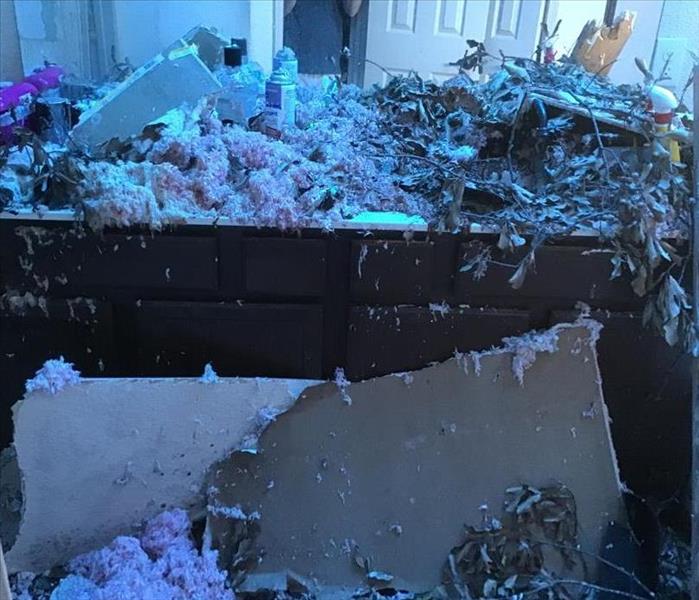 Storm damage in home
Storm damage in home
Severe storms are a regular part of Fort Worth weather. They flood homes quickly, leaving a mess of not only a homeowner’s personal property but also their residence itself. For homes with crawlspaces underneath, this can be a problem that affects the structural integrity, destroys items in storage, and even lead to a mold infestation if not dealt with quickly.
In these cases, waterproofing is needed for Fort Worth residential crawlspaces. SERVPRO restoration teams can seal off almost any type of leak into one unless there is major damage to the exterior walls or the sub-floor above it.
If standing water is a recurring issue with every rain, then the homeowner has two problems: Leaks and seeps into the crawlspace, and very slow or no drainage. Our technicians can address both of them simultaneously.
Team members remove water with a commercial pump and then use a combination of hand-drying methods and dehumidifiers to remove any moisture left in the crawlspace. Then they cover the dirt floor with thick, polyethylene sheets to serve as a vapor barrier, preventing water from seeping up inside. Team members extend these sheets up and onto the walls, securing them together and to the walls with two-sided, foundation tape.
Before securing them to the walls, however, an inspector carefully examines the walls for any cracks or leaks. SERVPRO specialists fill them with a hydraulic cement that blocks further water intrusion. Next, they seal every wall with a masonry cement that reduces water seepage from outside the home. Once they complete the walls, team members seal the polyethylene sheets in place.
Water can still penetrate through wood floors, however. In areas that flood regularly, the solution for recurring flooding may be to install a sump pump. These devices work automatically, and when water is detected, they switch on to remove it until the level returns to normal. Our technicians can install a sump pump and have it working in a day.
Our goal at SERVPRO of Northeast Ft. Worth is to help you return your entire home to a dry, safe condition, and keep it in that state as best as possible. If you need us to return your crawlspace to what it looked like before flooding; call us today at (817) 741-5737 to get started.
Seven Tips for Minimizing the Scope of Damage From Severe Weather in Haltom City, TX
8/17/2021 (Permalink)
Blog Summary: SERVPRO of Northeast Fort Worth highlights seven ways that Haltom City homeowners can lessen the impact of severe weather on their homes.
When severe weather strikes Haltom City, TX, and the surrounding area, SERVPRO of Northeast Fort Worth provides water and storm damage restoration services that help the community recover. Although storm damage may seem unavoidable, homeowners can prepare for thunderstorms and other severe weather by taking steps to reduce damage to Haltom City homes.
- Keep the treescape in top condition.
Trees in the yard could pose a threat to the home and nearby structures during heavy rains and high winds. Excessive amounts of rain loosen the soil around the roots of the tree, weakening the tree’s ability to remain standing in the path of high winds. The tree could topple onto the home, damaging the roof resulting in a water intrusion. A domino effect could occur in which one tree causes other trees to uproot. Hire an arborist to trim the trees around the home, eliminate overhanging branches, and remove diseased, dying, or dead trees.
The director of operations and urban forestry at Texas Trees Foundation offers the following tree care tips:
- Avoid hiring just anyone to remove fallen trees and debris when severe weather damages the treescape. Individuals with a chainsaw and pickup truck will drive through affected neighborhoods offering tree removal and cleanup services at a very low price. If a problem arises, the crew will disappear, leaving the homeowner with an even larger problem.
- Always hire a qualified, bonded, and insured tree service to remove any fallen trees. Incorrect pruning can cause damaged trees to fall victim to high winds during the next severe thunderstorm. If an uninsured tree service company damages the house, the homeowner could be held liable. An insured company will cover any further damage to the structure.
- Hire a certified arborist for the best treescape care. To ensure the treescape receives the best care, hire an arborist to prune the trees at least once a year. A competent arborist will shape the trees so that they are beautiful, healthy, and safe.
- Avoid cutting down trees if at all possible. Trees are an asset, and a well-managed treescape can add as much as twenty percent to the overall value of a property. Homeowners should invest in their trees, which add value and beauty to a home.
- Install a lightning surge protector.
According to DisasterSafety.org, a resource from the Insurance Institute for Business and Home Safety, a lightning surge protector for the home costs between $300 and $500 and requires one to three hours to install. A whole-house surge protector can help prevent costly electronics from being destroyed by a lightning strike to the home.
- Construct protective screens around HVAC units.
For a relatively low budget, an industrious homeowner can add years to the life of an HVAC unit by constructing a screen around the unit. The screen shields the coils and fins of the unit from hail damage. In hail-prone areas such as Northeast Fort Worth and the greater North Texas region, a hail screen makes sense.
- Upgrade to a wind-rated garage door or reinforce the existing door.
Older unreinforced garage doors are vulnerable to damage from high winds. High winds cause the door to bow inward. The increased air pressure in the garage is strong enough to cause structural damage to the roof and surrounding walls. Wind-rated garage doors are manufactured to tolerances that can withstand high winds without allowing the home to sustain damage.
The homeowner who is unable to purchase and install a new wind-rated garage door can reinforce the existing garage door. The bracing must be in place ahead of severe weather.
- Upgrade to steel gutters and downspouts.
Inadequate or damaged gutters are a common source of water damage in the attic and in the walls of a home. Because steel is stronger than vinyl and aluminum, it is less prone to leakage.
- Upgrade to better quality impact-rated shingles when repairing or replacing a roof.
Wind, hail, and water damage are some of the most common causes of property damage, and the roof is a home’s first line of defense against severe weather. Homeowners can help prevent a water damage headache by replacing shingles. High-impact, better-quality shingles may qualify a homeowner for an insurance discount.
- Pre-qualify a property damage restoration company before storm damage.
SERVPRO of Northeast Fort Worth specializes in storm damage cleanup and restoration for residential and commercial properties. The team provides emergency tarping, board-ups, security fencing, pack-ups, and storage. Technicians also provide restoration services after a fire, smoke, or water damage incident and can perform mold and mildew remediation.
For more information about water damage restoration in Haltom City, TX, contact SERVPRO of Northeast Fort Worth, TX, by calling (817) 741-5737. The office can also be reached by email at office@SERVPROnortheastftworth.com.
Why Tarping Should Be Implemented Quickly After Storm Damage That Causes Water to Enter the Home
5/6/2021 (Permalink)
Blog Summary: SERVPRO of Northeast Fort Worth highlights the benefits of quickly securing emergency tarping services after storm damage.
A locally owned and operated business, SERVPRO of Northeast Fort Worth is the leading storm damage restoration company serving the Fort Worth, Keller, and Park Glen areas with continuous coverage twenty-four hours a day, seven days a week. When severe weather damages a home, SERVPRO technicians are ready to respond to any disaster.
The Importance of Emergency Roof Tarping When Disaster Strikes
The roof, an essential part of any structure, is designed to protect the occupants and their belongings from the elements. A tiny roof leak can cause major property damage issues, including potential water damage to ceilings and walls, structural damage to support beams, and a full-blown mold infestation hidden in the attic and behind walls.
Unfortunately, most instances of major roof damage occur during severe weather situations. Intense thunder, torrential rain, pelting hail the size of a quarter, high winds, and even tornadoes wreak havoc on the roof. Shingles are ripped up and blown away. Plywood sheeting takes flight in high winds. The exposed attic yawns to receive rain and hail.
The roof damage may not be limited to one roof. Most likely, dozens, if not hundreds, of homes in the same area have been impacted to some extent by the wind, rain, and hail. In some instances, limbs and trees may have toppled onto the home, inflicting damage to the entire structure and not just the roof.
It could be days before a roofing contractor is able to inspect the damage and weeks before the damage is repaired. In the meantime, unless an intermediate solution is found, buckets of rain will pour through the roof, expanding and worsening the extent of the water damage. In warm, moist conditions, mold can begin to grow in one to two days.
The Benefits of Emergency Tarping
Homeowners may wait for weeks before receiving proper roof repair services. The intervening solution is emergency roof tarping. Emergency roof tarping can be the difference between minor water damage in the attic or collapsed ceilings, ruined flooring, significant structural damage, and a massive mold infestation. A minor leak may lead only to an inconvenience. A massive breach in the roof could be unhealthy and very dangerous.
Is Emergency Roof Tarping Effective?
Homeowners can minimize water damage with emergency roof tarping. Tarping effectively stops the leak by covering the damaged area. Stopping the flow of water, even if it is minuscule, prevents the damage from expanding. It also gives the wet areas of the attic and ceiling time to dry out.
Many roof leaks are small and barely noticeable at first. Most homeowners do not regularly inspect the roof after a storm, and many homeowners who do visually inspect the roof after severe weather are not sure what to look for. If water damage is negligible and limited to an obscure or inaccessible area such as the attic, the damage may go unnoticed for quite a while.
The main benefit of emergency roof tarping is to stop a small roof leak that does little damage from becoming a larger roof leak that causes widespread damage. Though emergency roof tarping is temporary, it works well in the short term until roofing services can be scheduled.
Steps in the Tarping Process
Step #1: Prepare the roof for the tarp.
Professionals with ladders and safety gear must clear out any debris such as damaged plywood, shingles, and other roofing materials.
Step #2: Evaluate the damage and prepare a restoration estimate.
The area of concern must be inspected to assess the damage and estimate the cost of the repairs.
Step #3: Make temporary structural improvements to support the tarp.
Plywood and support timber are applied to the damaged area before the tarp is installed. The additional construction supports the tarp and serves as a second water shield in case the tarp fails.
Step #4: The emergency tarp is installed.
Workers place the tarping on top of the plywood and secure the tarp with lumber. Tarping is only temporary and may not completely stop all water leaks. Water damage losses may expand until the roof is permanently repaired, and these additional minor losses will be added to the insurance claim.
Why Would a Homeowner Need Emergency Tarping?
What are some situations where a homeowner would need emergency roof tarping?
- Hurricanes, tornadoes, or severe weather damage a roof
- Delays in roof repairs require interim tarping
- High winds cause branches or trees to fall on a roof
- A home inspection prior to a home sale turns up a roof leak
The experts at SERVPRO of Northeast Fort Worth specialize in the cleanup and restoration of property damage caused by hurricanes, tornadoes, or severe weather. Technicians can provide emergency tarping, board-ups, security fencing, pack-ups, and storage.
To learn more about storm damage restoration in Keller, TX, contact SERVPRO of Northeast Fort Worth, TX, at (817) 741-5737 or email the office at office@SERVPROnortheastftworth.com.
Flooding from Storms Needs Immediate Extraction--Call SERVPRO
4/9/2021 (Permalink)
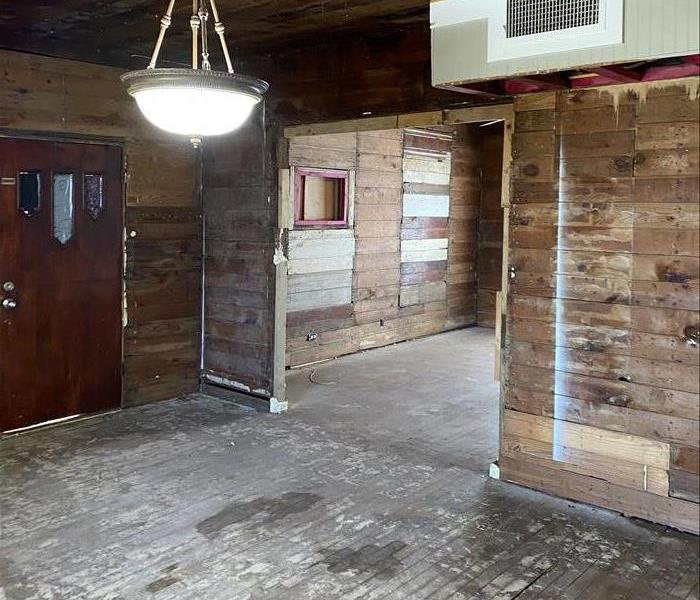 Post Storm Mitigation
Post Storm Mitigation
Removing standing water after a storm needs to happen immediately after the event occurs. Calling a professional water removal company can have the right amount of personnel, equipment, and resources on your doorstep quickly enough to prevent saturation of critical areas of your Fort Worth home.
Reliable water removal services are available throughout the Fort Worth area. You obtain 24/7 emergency response service, a no-cost estimate of damages found on your property, and a highly trained team of professionals ready to ensure your water removal gets done right.
Extracting standing water and drying the entire structure of your home may sound like an easy task. However, since every situation is different, there is always the chance of something going wrong. You need a skilled team of IICRC-industry certified professionals that can adjust on the go, making changes needed to provide you with a successful restoration.
Leaving flood waters on your property for an extended amount of time can cause severe damage to the structural integrity of your home's support system, walls, ceiling, flooring, and insulation. Hesitating may also cause corrosion, and rot, leading to additional problems as time goes on, if mold has the opportunity to set in, restoring your home requires additional services.
SERVPRO's qualified technicians utilize a variety of water location and extraction equipment to ensure proper water removal on your property. Everything from hand-held portable units to truck-mounted water extractors, infrared moisture detectors, hygrometers, dehumidifiers, air-movers, and attachments make finding, removing, and drying the affected area easier.
SERVPRO crews are standing by to provide you with the services and technical knowledge necessary to return your home to a quality condition after heavy storms, rain, or flooding occurs in your home. Make the most of what is available in your area and give us a call, today.
SERVPRO of Northeast Ft. Worth offers quality solutions to residents in Fossil Creek, Keller, and Park Glen, as well as other surrounding communities. We are proud to serve, providing water removal, cleaning, and restoration services you can trust. (817) 741-5737
Common items affected by water damage in your home
4/9/2021 (Permalink)
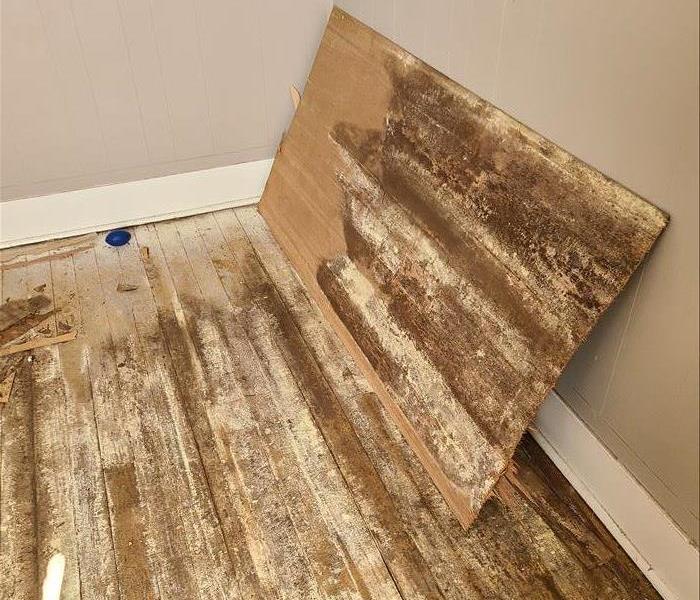 Flooring affected by water damages
Flooring affected by water damages
Ground-floor bedrooms can be among the most heavily affected rooms in a home in Fossil Creek when flood damage hits. While sleeping areas on second floors may be safe from most of the effects of rampaging floodwaters, ground floor and basement bedrooms contain many amenities that may be more vulnerable to severe water damage than objects found in other parts of the home. SERVPRO excels in restoring materials without having to replace them whenever possible, but we still see some of our most challenging work cut out for us wherever bedrooms are concerned.
Bed Sets
Flood damages can cause costly damage to sheets, mattresses, pillows, and any other parts of a bed. For some homeowners, these items can represent a combined total of thousands of dollars in value. One of the primary things we do after arriving and ask many residents to do before we get there is to separate pillows, sheets, and other layers from each other. Keeping these items separated out early on helps them to dry out faster and prevents color bleed from taking place.
Carpeting
Most local homes fill their bedrooms with carpeting and rugs that can sustain severe damage in the event of a flood. Storm floods typically cause warping, discoloration, and material degradation in both the upper layers of carpeting and in the padding below them. Depending on the conditions, we may be able to replace sections of carpeting while keeping other areas intact selectively, but most floods force us to replace flooring in carpeted rooms entirely.
Valuable Belongings
Many valuable personal items are stored in the average bedroom, including electronics, clothing, objects of sentimental value, and a wide range of other possibilities. While some items may be lost forever after being inundated with water, others may yet be salvaged. We examine every damaged item individually to determine if and how we should attempt to clean and restore it.
SERVPRO of Northeast Ft. Worth helps local homeowners to recover from the effects of flood damage on a 24/7 basis. Call us at (817) 741-5737.
Eight Tips to Help Homeowners Prepare for Tornado Season and Minimize Storm Damage
3/4/2021 (Permalink)
Blog Summary: SERVPRO of Northeast Fort Worth offers seven tips on how homeowners can prevent storm damage during the upcoming tornado season. Should storm damage occur, the team at SERVPRO of Northeast Fort Worth can quickly be on the scene as soon as it is safe to begin providing damage restoration services.
Locally owned and operated, SERVPRO of Northeast Fort Worth is the premier residential and commercial storm damage restoration company serving the Fort Worth, Keller, and Park Glen areas. SERVPRO technicians are the best trained in the industry. Having the highest IICRC standards means customers can trust the property damage restoration team to handle any property damage disaster.
As tornado season approaches, SERVPRO of Northeast Fort Worth urges homeowners to be prepared. Following the simple measures listed below can prevent or limit unnecessary property damage, save money on costly repairs, and save lives. Should storm damage occur, the team at SERVPRO of Northeast Fort Worth can quickly be on the scene as soon as it is safe to begin providing damage restoration services.
Tip #1: Know when to expect peak tornadic activity, and keep an eye on the weather.
In an article explaining the tornado season in Texas, the experts state: “While tornadoes can occur all year long, tornado season in Texas runs from March through August. During these months, it is not uncommon for several tornadoes to occur at once. The way tornadoes form is not completely understood, but scientists believe they begin when wind shear causes thunderstorms to rotate. As the winds rotate faster, a funnel cloud is formed, and if this cloud reaches the ground, it is called a tornado.”
Understanding what a tornado is and how it works can create a healthy respect for the power of these potentially devastating meteorological events. Anyone who has personally experienced a tornado has both seen and felt the unleashed power of these storms. A prior experience with a tornado can be a driving motivation to take precautionary steps when tornado season arrives.
Tip #2: Create a list of items to bring inside in the event of severe storms or tornadoes.
The list serves a dual purpose. First, the preparation of the list prepares the mind to think quickly when a storm arrives. It is doubtful that anyone braving high winds, pelting rain and hail, and lightning would be checking off items as they were being collected and stored in the home or garage. However, when minutes count, having a mental list can save time and possible injury from flying debris. Items to store may include:
- lawn and pool furniture
- flags, hanging bird feeders, wind chimes
- portable solar lights
- grill, fire pit, and outdoor fans
- bicycles, skateboards, toys
Tip #3: Clear away any debris and loose items in the yard or on the patio or porch.
Potted plants, garbage cans, dog houses, branches, and even firewood may become missiles when launched by the turbulent winds of a tornado. These and other wind-born items can shatter windows, penetrate siding, and demolish vehicles.
Tip #4: Prune trees so that they are less vulnerable to damage from high winds.
Remove damaged and diseased limbs that can break off and become deadly projectiles. Thin out the larger branches to allow wind to flow through the trees. The services of a bonded, insured, and reputable tree service company will be required to perform these measures safely.
Tip #5: Reinforce garage doors.
Garage doors are often damaged by high winds and airborne debris. If the garage door is destroyed, wind-driven rain and hail can cause serious water damage to the contents of the garage, and any vehicles in the garage can be damaged from debris and hail. High winds ripping into the garage can contribute to catastrophic roof failure and possibly the destruction of the entire home.
Tip #6: Weigh the benefits of installing sturdy permanent storm shutters to cover windows.
Though not as devastating as a direct hit from a tornado, large hail and microbursts can cause extensive damage. Wind-driven hail the size of a baseball or larger can impact a home at speeds exceeding 100 miles an hour. Once a window shatters, rain can wreak havoc inside the home. Shutters can be rapidly closed to protect the windows.
Tip #7: Fortify the home.
The insurance experts at Access Home Insurance offer the following recommendations: “Call a professional to reinforce any masonry walls or other structures that provide support to your home. If you have a chimney, have the professionals secure it with reinforced steel to prevent it from falling off during high winds. Professionals can also assess your home and make recommendations to add additional strength and stability.”
Tip #8: Pre-qualify a property damage restoration company to provide services before the calamity strikes.
SERVPRO of Northeast Fort Worth specializes in the cleanup and restoration of residential and commercial properties damaged by a storm. The company can provide emergency tarping, board-ups, security fencing, pack-ups, and storage. The dedicated team also provides restoration services after a fire, smoke, or water damage incident while also handling mold and mildew remediation for the home or business.
For more information about storm damage restoration, contact the SERVPRO of Northeast Fort Worth, TX, at (817) 741-5737 or email office@SERVPROnortheastftworth.com.
How Long Should It Take To Fix Flood Damage In Fort Worth?
11/3/2020 (Permalink)
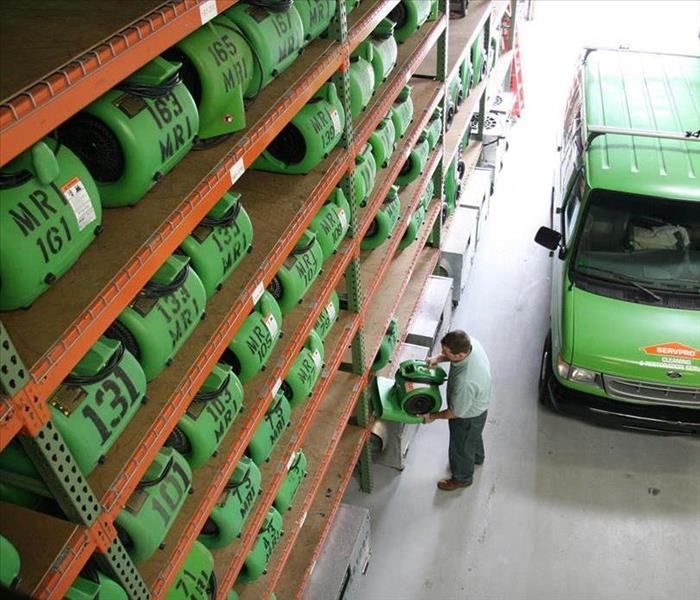 Warehouse of Drying Equipment
Warehouse of Drying Equipment
Fort Worth residents are accustomed to storms rolling in out of a perfectly beautiful afternoon. They make for some interesting skies to watch and photograph, but the resulting floodwaters can cause homeowners thousands of dollars in restoration costs.
Cleaning up the debris and soiling left over after flood damage in Fort Worth may seem daunting, but it is hardly the most challenging task, primarily when handled by a skilled team with sophisticated equipment. Our SERVPRO technicians use simple equipment such as shovels, as well as advanced ones like power washers to remove soils from the property quickly.
Drying excess water left over after flooding incidents can take time. Water loss incidents that affect your Fort Worth property often prevent you from staying in the home or building. As water sits in the property, it soaks into different materials complicating the removal process. Our highly trained technicians use a variety of equipment including air movers to speed up the drying process. Typically, one air-moving unit can cover 150 to 300 square feet since we remove carpets and pad for disposal instead of drying them. By calculating the total square feet affected in the incident, we can estimate the expected turnaround time for drying.
Restoring flood damage can take longer if secondary problems develop. Mold infestation and deterioration of materials such as wood through rotting and warping add extra steps lengthening the process. Where possible, our technicians take precautions to prevent these problems. We try to dry materials within 48 hours to prevent mold development. We also set drying goals that lead to balanced drying preventing problems such as cracking. In case we cannot prevent the issues, put our building service skills to use tearing down affected areas to replace affected materials and refinish surfaces to deal with the problem - we are Here to Help.
For fast restoration after a flooding incident, call SERVPRO of Northeast Ft. Worth at (817) 741-5737 to help. We are available 24/7.
How to Prepare for Severe Weather
10/2/2020 (Permalink)
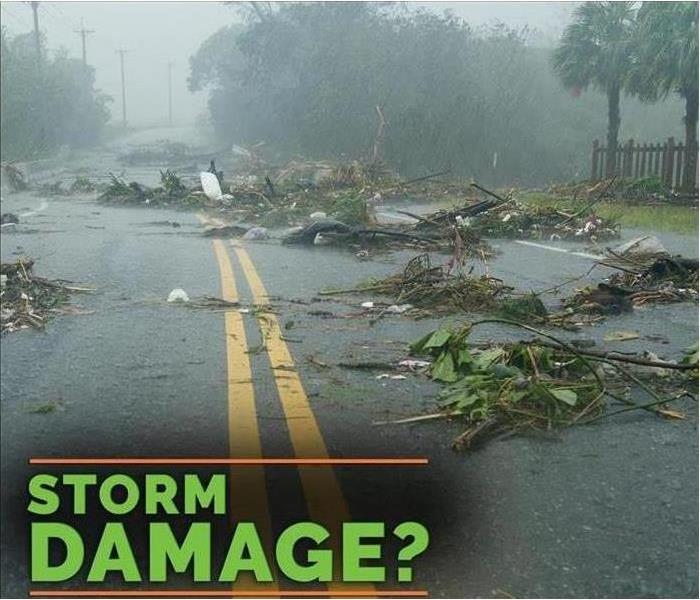 Storm Damage
Storm Damage
Northeast Ft. Worth residents and other North Texans are familiar with the destructive power of storms. On October 20, 2019, residents of North Texas lived through what Forbes Magazine describes as “the most costly tornado in Texas history.” While thankfully no lives were lost, Texans suffered “more than two billion in damages, according to the Insurance Council of Texas. More than 30,000 auto and residential claims have been filed to date…”
The same article notes that claim costs could be even higher because the storm and tornado tore through Preston Hollow, a high-end Dallas neighborhood loaded with multi-million dollar estates.
The EF-3 tornado cut a wide path nearly 16 miles long, leaving unbelievable devastation in its wake. Not since 1976 had a tornado that powerful roared through the area.
Nine Storm Preparation Tips
- Get and stay informed.
Tune in to the local radio or TV station and community alert system for emergency information. Keep a battery-operated/solar-powered radio on hand.
- Inspect the emergency survival kits and the food and water supply.
The emergency kits should be stocked with essential items. If one or more are not available, purchase the necessary items to properly outfit the kits. Stock up with a two-week supply of food and water. The tornadoes that hit the North Texas area in 2015 and 2019 left thousands of homes and businesses without power for weeks.
- Round up plenty of LED flashlights and batteries.
LED flashlights burn much brighter and last much longer than traditional flashlights. Heavy-duty solar-powered landscape lights can perform a double function as an attractive landscape feature and as an emergency light. Gather them up before the threatening storms, tornadoes, or approaching hurricane.
- Fully charge the car chargers.
The chargers can be used to charge a personal cell phone, smartphone, and other portable devices.
- Secure all outdoor furniture.
Secure outdoor furniture and other objects or move them inside. An EF-2 (135 mph) or EH-3 (140 mph) tornado can destroy an outdoor swing or trampoline. Deck furniture can disappear never to be seen again.
- Collect tools and emergency building materials.
Sandbags, plywood, and waterproof tarps will come in handy if windows are blown out, or a roof is torn off, or the shingles are damaged. Keeping as much water as possible out of homes and businesses will reduce damage to the interior. Keeping the inside as dry as possible will hinder the growth and spread of mold.
- Fill up automobiles and equipment.
Store fresh fuel for the emergency generator if one is available. Use approved fuel containers and store the fuel in a safe, dry place.
- Know how to shut off the utilities.
Should the home or business receive extensive damage, it may be necessary to shut off utilities, such as gas, electricity, and water. If evacuation is required, turn off utilities before leaving if time permits.
- Gather documents and records.
After a severe storm disaster, residents may need ID to prove who they are. Gather and store ID documents in a portable waterproof, fire-safe security chest. Important identification documents include birth certificates, Social Security cards, marriage certificates, adoption papers, passports, naturalization documents, wills, living wills, powers of attorney, and property deeds/titles. If there is room in the chest, include essential or memorable DVDs, portable disks, and flash drives. A better solution may be to create a document cache with files and images of relevant documents, ID cards, and photos. This cache can be stored on the cloud, and duplicated on a flash drive that is kept on hand. Personal IT management is essential, especially during and after a house fire or natural disaster.
Conclusion
Preparation is the key to weathering the storm when it hits. When it does, contact a storm damage restoration specialist. Emergency tarping and boarding, site stabilization and security, immediate water damage restoration, and other disaster recovery procedures can best be implemented by expert technicians facilitated by advanced equipment and technologies.
SERVPRO of Northeast Ft. Worth is a trusted leader in the restoration industry as well as in the local community. They provide 24-hour emergency service and are dedicated to responding faster to any size disaster. They pride themselves on having not only the training but also the expertise to handle their customer's restoration and cleaning needs. They are locally owned and operated and can respond immediately to an emergency. Being locally owned, they make every effort to stay involved in the community providing their time and services when needed.
For more information about storm damage cleanup, call SERVPRO of Northeast Ft. Worth at (817) 741-5737 or email office@SERVPROnortheastftworth.com.
We Provide Flood Damage Restoration in Keller
5/15/2020 (Permalink)
Severe thunderstorms can cause damage and flooding in your home. A tree branch can fall on your roof, leaving a large hole for water to come in. Acting fast can prevent significant damages to your home. If you hesitate to call a professional, it could lead to the loss of furniture and belongings and could ruin your walls and flooring. When possible, our team can restore your property and save many of your items.
SERVPRO flood damage restoration in Keller and surrounding areas involves inspecting the damages and securing your home. Our techs can cover the hole in your roof with waterproof tarpaulins or with plywood. They also can check for broken windows or missing doors and can board or cover and seal them. We secure entry points to your home to prevent water from entering the premises. Plus, it helps keep birds, squirrels, and other animals from invading your residence.
Our technicians know that responding fast can reduce damages and work quickly to remove water from inside your home. They can use portable or truck-mounted extractors or commercial grade pumps and wet vacuums to eliminate water from the structure. Rapid water removal can also prevent secondary water damages such as rot and mold growth. We strive to get to your home promptly and begin the job as soon as we arrive to help reduce restoration costs and the number of damages.
Storm waters can also ruin interior walls, flooring, and ceilings. Our techs may have to remove wet materials like carpeting, drywall or insulation. If further construction is necessary, we can help homeowners get in touch with a general contractor. Flood waters contain toxic substances, which mean our techs must throw out all contents like carpeting, padding and any furniture that may come in contact with the water. During the drying phase, we may use air movers and industrial axial fans to dry the structure thoroughly. The crew may also employ dehumidifiers to reduce moisture levels.
If you need reliable and efficient flood damage services in your area, call us 24/7 at (817) 741-5737. SERVPRO of Northeast Ft. Worth can get the job done. We are always nearby and ready to help.
Stormwaters Are No Match for SERVPRO's Technicians and Equipment
5/1/2020 (Permalink)
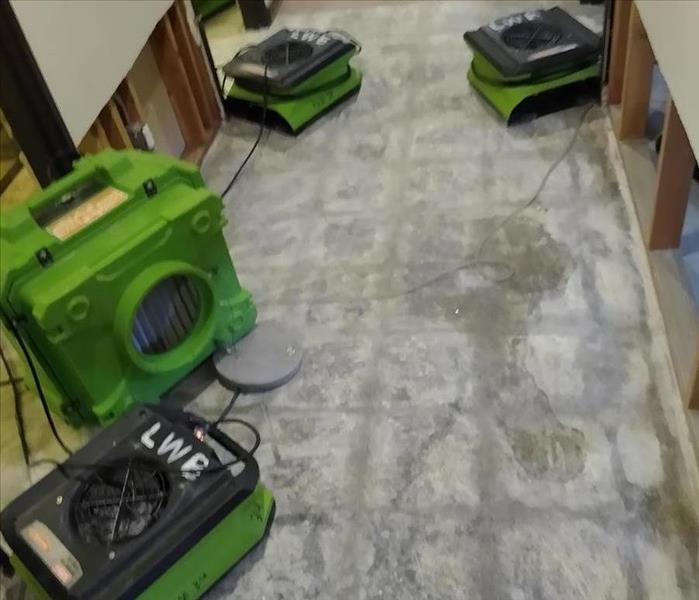 SERVPRO fans drying out structure
SERVPRO fans drying out structure
Planning for flash flooding in Ft. Worth is hard. Its very definition indicates that it was unpredictable. Thunderstorms brew in our area, bringing relief in times of drought, but there is no way to shut the rain down when it transforms from welcome to a disaster. When water flows into the lower levels of your home, you need our help fast.
The Fort Worth area experienced flood damage during recent storms, and your house is on the list of affected properties. You feel overwhelmed, but a referral from a friend brought you together with our trained flood restoration team. We get immediately to work on the damage done to your foundation and crawl space because we understand just how devastating standing water can prove to be.
Our service vehicles are equipped with nearly every piece of equipment imaginable to remove water and begin drying out the area. We chose to operate this way so that no time is lost in arranging for the necessary tools. Gas powered pumps and truck mounted water extractors get the job done regardless of whether the power is out. Quickly responding to this kind of water loss is at the core of the services we provide, and our customers relax at least a bit when our big green SERVPRO trucks arrive. Flash flooding can be decisive and swift in destroying properties.
Even if a number of your neighbors also experience flood damage, you do not stand in line waiting for our assistance. We scale up our services in response to the crisis you and perhaps the rest of community experience. If needed, we tap into our nationwide network of other SERVPRO disaster response companies.
Delay in removing water and drying out structure and contents is not acceptable to us as it results in irreparable damage. Fast action means most building materials are still restorable and fixtures such as carpeting and cabinetry respond to the skills of our highly-trained technicians. SERVPRO employees inventory and pack out possessions and stage them in a dry area of your home or our facility. You review what items you desire restored through special techniques like freeze drying as our crews extract the water and position air movers and dehumidifiers to dry out the flooded area.
You need SERVPRO of Northeast Ft. Worth by your side when the floodwaters fill your foundation. Call (817) 741-5737 for immediate assistance 24 hours a day.
Storm Damage Repair And Restoration
4/3/2020 (Permalink)
 Storm showers can affect your home in a big way
Storm showers can affect your home in a big way
An average rain shower can be pleasant to listen to as you fall asleep but when a massive storm hits your home and does severe damage, the water removal process can be anything but relaxing. Storms are destructive and can easily flood your home with excess water. Additionally, this water might not always be safe. Because the intense weather can flood hundreds of gallons of rainwater into your home, it is possible to end up with a mess that you just cannot clean up yourself. Fortunately, you do not have to.
When water has invaded and taken over your Keller residence, trust our IICRC-certified technicians to remove it from your property swiftly. We use powerful industrial grade wet/dry vacuums to remove all of the excess water so we can get your home back to the condition it was in before the storm hit. Upon calling our office, our technicians can be on the scene as soon as possible.
We can remove the excess water from your home, and once we do, we can move onto the drying process. SERVPRO understands how valuable your carpets are to you and know that a flood can soak them thoroughly and dirty them. Depending on the type of water that flooded your home, SERVPRO can determine if your carpets are salvageable and clean them entirely if they are. Underneath your carpets, we can focus on your floorboards. SERVPRO uses advanced equipment like dehumidifiers and air movers to eliminate harmful moisture in the air and dry out your belongings.
In rare cases, intensely contaminated black water can flood your home from the storm's influence. Should your house be flooded with unsafe water, we can guide you through what you can keep and what you should not. SERVPRO is with you every step of the way to make an inventory of your belongings and assist with your claims process.
When a storm hits your home, and it becomes flooded with excessive water, do not wait. Call SERVPRO of Northeast Ft. Worth area at (817) 741-5737 to remove it. 24/7, we are ready to take your call and return your home to its preloss condition.
Storm Preparation
3/13/2020 (Permalink)
How to prepare for a storm:
Before the storm –
- Check your gutters, and clear out any debris that may be clogging them. Also assess your area for storm drains in low lying areas, and make sure those are clear as well.
- Remove fallen leaves and other debris from your yard.
- If you are in a flood zone, keep sandbags on hand and put up valuables.
- Check your insurance to see if you are covered for floods.
- Figure out the safest route from business to home. If your home is located in a flood zone, make a plan so that all family members understand were the closest safe ground is and how to get there.
- Ensure a plan is in place for family pets, as well.
- Make a list of valuables that you can keep in a safe place.
- Put together some supplies, such as food, water, a first aid kit, and medications together in a safe area in case they are needed. Also include flashlights, batteries, and a radio if possible.
- Fill up your gas tank in your car.
During the storm –
- Monitor the TV and radio for weather updates. If an evacuation is advised, evacuate quickly and safely. A good source is http://www.weather.gov/
- If water enters your home, evacuate to a higher ground even if there is no evacuation order in place by officials.
- If traveling, watch for washed out roads and downed power lines. Turn around, don’t drown!
After the flood –
- Make sure your drinking water is clean to prevent illness. Boil water for three to five minutes and then let cool before drinking. Alternatively, purchase bottled water from the grocery store.
- Check your home for moisture on the walls, carpets, and furniture. Dampness can cause mold and mildew. Open windows and turn on your heater to approximately 15 degrees higher than the outside temperature to facilitate drying.
- Practice good hygiene such as hand washing to help prevent illnesses.
If in the event your home has water damage call SERVPRO of Northeast Fort Worth to help remediate the issue at 817-741-5737
Professional Equipment Makes the Difference in Fort Worth Flood Damage Cleanup
10/6/2019 (Permalink)
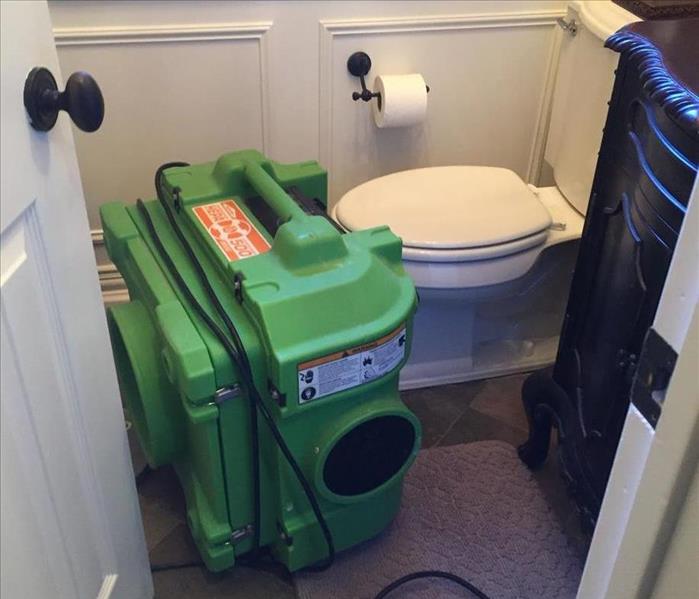 We have what it takes to knock out your Fort Worth flood damage in your home.
We have what it takes to knock out your Fort Worth flood damage in your home.
SERVPRO will clean your flood damage in Fort Worth the right way.
Two things about flood damage when it occurs: first, cleanup has to start quickly. Second, all water requires the removal and inadequate extraction of water leaves the property open for more costly issues.
SERVPRO technicians utilize a wide array of water extraction equipment when working on flood damage in a Fort Worth property. Each surface and amount of water dictates the type of removal equipment chosen for use. Before water removal efforts commence, technicians scope the property using different kinds of moisture detection devices to ascertain areas where there are excessive levels of moisture that require extraction or drying attention.
Water Extraction from Carpet
In cases of wet carpeting from rainwater entering the home and the cleanup started within 24 hours, there is potential for restoration of the carpet. SERVPRO technicians use a host of tools such as pumps with weighted carpet wands or deep extractor tools, and Rovers that use the weight of a technician to push water out of carpeted surfaces. When carpet absorbs groundwater, there is no restoration potential. The technicians extract the water and cut the carpet into strips for easier handling.
Hardwood Flooring with Water Damage
Wood flooring constructed from composite never fares well with water exposure and is generally a loss. Hardwood flooring has restoration potential on a case by case basis partly determined on the category and length of water exposure. SERVPRO technicians use squeegee attachments with wet vacuums and follow up using drying mats to limit the warping or buckling.
Special Attention to the Subfloor
When water enters a property, it follows the path of least resistance and migrates into the subflooring rapidly. The use of inadequate or improper removal methods leaves the property open for the weakening of the building materials, foul odors, and mold infestations. Technicians use squeegee attachments when pooling water is an issue.
SERVPRO of Northeast Ft. Worth at (817) 741-5737 is ready to handle flood damage in your home. We're Faster to Any Size Disaster and restore the house to its pre-flood condition.
To find out more about Fort Worth, click here.
Some Shortcuts to Fort Worth Flood Damage Remediation Success
9/8/2019 (Permalink)
 Flooding and flood damage can literally put you out of your home. Contact our certified team for a fast response.
Flooding and flood damage can literally put you out of your home. Contact our certified team for a fast response.
The High-Power Cleaning Agents Used to Disinfect Flood Damaged Fort Worth Homes
Disinfecting surfaces after flood damage is one of the most important safety measures we can take. Many types of floodwater harbor dangerous bacteria, fungi, and other microbes, and mold spores tend to overgrow whenever flooding happens. SERVPRO technicians use a variety of disinfectant products to help us target microbes more efficiently and without damaging your home.
Quaternary Compounds
The disinfectants we use the most for flood damage situations in Fort Worth are known as quaternary compounds, or "quats" for short. These products have many beneficial qualities when used for home damage restorations. First and most importantly, they are typically very effective against bacteria and fungi alike, allowing us to counteract many potential biohazards at once. However, unlike other disinfectants, quats have almost no potential to cause damage to any materials in your home and even give off a pleasant odor. Because these compounds are so versatile and helpful, we use them regularly throughout our flood damage restorations.
Chlorines
Chlorine-based disinfectants are even more potent than quaternary compounds but have some limitations and safety precautions that reduce their versatility. While chlorine chemicals can be applied to porous surfaces like wood and fabric, they can damage some other types of materials, mainly surfaces with delicate finishes. Also, the smell of chlorine is strong and difficult to counteract. Because of these limitations, we only use chlorine-based chemicals when quats prove to be insufficient.
Phenolics
Phenolic cleaning chemicals are the strongest we have in our arsenal, but also potentially the most harmful. These chemicals are useful for some of the worst flood damage cases we see, where filthy water may contaminate an entire home and create a significant biohazard. Unlike most antibiotics, these chemicals can even neutralize viruses. However, because phenolics have a strong foul odor and may be hazardous when used incorrectly, we reserve them for the most severe situations.
Botanical Disinfectants
While less potent than quaternary compounds, botanical disinfectants are similarly versatile, and many of our customers prefer us to use them over stronger chemicals. Let us know if you would prefer us to use one of our botanical alternatives on your home.
SERVPRO of Northeast Ft. Worth maintains a constant stock of some of the most powerful and specialized cleaning agents approved for use in residential buildings. For our expert mitigation and restoration services after a flood, call us 24/7 at (817) 741-5737.
Click here to see more info about the city of Fort Worth.
Now You Can Have Flood Damage Remediation in Your Fort Worth Home Done Safely
7/3/2019 (Permalink)
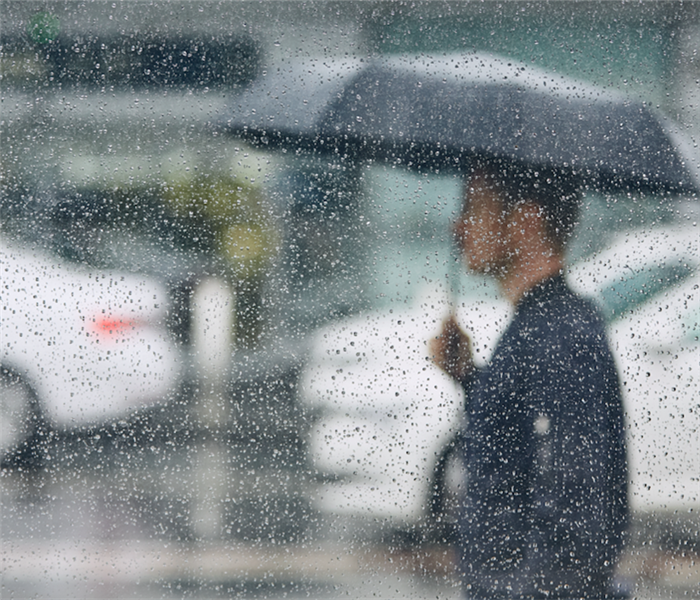 Flood damage almost always occurs at the most inopportune times. Contact SERVPRO today for all remediation needs.
Flood damage almost always occurs at the most inopportune times. Contact SERVPRO today for all remediation needs.
Flood Damage in Your Fort Worth Home? Call Us!
Summer storms in Fort Worth are a common occurrence. Large puffy clouds regularly roll over the area, helping keep the weather cool in the summer. However, it’s important to keep in mind that clouds can quickly unleash torrents of rains, causing flooding in your home.
Often flood damage in Fort Worth homes occurs after heavy storms. If this happens to you, then you need professionals who can quickly work to resolve your issues. Our teams of SERVPRO water damage restoration technicians (WRT) can arrive on your property within hours of your call to begin extracting water. We can utilize industrial grade wet vacs and pumps to speed up the process. Floods typically consist of Category 3 black water, which can soil absorbent substances, forcing us to discard them.
As a homeowner, you have several options for mitigating any further damage before SERVPRO crews arrive. Here are some tips we recommend you follow to help reduce damages:
- For your personal safety, make sure to wear protective clothing (such as tall rubber boots) before coming into contact with contaminated water.
- Extract contaminated upholstery pieces from your home so tha they can be properly disposed of.
- Move your furniture out of the flood waters.
- Wipe down wooden sections of furniture with a wet rag to help prevent the formation of water lines.
Once we are present, we can remove absorbent materials such as carpeting that can be more difficult for you to remove on your own. This can be accomplished with the use of carpet removal tools. We can then use air movers and dehumidifiers to pull moisture out of your sub flooring to fully dry it.
Additionally, we can identify hidden moisture in your home using moisture sensors after pumping out the flood water. This allows us to identify areas that require further use of dehumidifiers and air movers to fully dry out.
We have extensive experience in mitigating the damages brought on by flooding. If you find yourself the victim of a storm, then call SERVPRO of Northeast Ft. Worth. You can reach us at any time during the week at (817) 741-5737.
Click here to see more about Fort Worth.
After A Flood Our Crew Can Help Restore Your Fort Worth Home
4/24/2019 (Permalink)
 For fast restoration after a flooding incident, call SERVPRO of Northeast Ft. Worth at (817) 741-5737 to help. We are available 24/7.
For fast restoration after a flooding incident, call SERVPRO of Northeast Ft. Worth at (817) 741-5737 to help. We are available 24/7.
How Long Should It Take To Fix Flood Damage In Fort Worth?
Any homeowner hit by a flooding incident feels anxious wondering whether it is possible to restore the property to its preloss state. Among the thorny issues you have to deal with, is determining how long the restoration is likely to take so that you can make other plans if necessary. A professional restorer can help provide an estimate based on the time it takes to accomplish different aspects of the restoration process.
Cleaning up the debris and soiling left over after flood damage in Fort Worth may seem daunting, but it is hardly the most challenging task, primarily when handled by a skilled team with sophisticated equipment. Our SERVPRO technicians use simple equipment such as shovels, as well as advanced ones like power washers to remove soils from the property quickly.
Drying excess water left over after flooding incidents can take time. As water sits in the property, it soaks into different materials complicating the removal process. Our SERVPRO experts use a variety of equipment including air movers to speed up the drying process. Typically, one air-moving unit can cover 150 to 300 square feet since we remove carpets and pad for disposal instead or drying them. By calculating the total square feet affected in the incident, we can estimate the expected turnaround time for drying.
Restoring flood damage can take longer is secondary problems develop. Mold infestation and deterioration of materials such as wood through rotting and warping add extra steps lengthening the process. Where possible, our SERVPRO technicians take precautions to prevent these problems. We try to dry materials within 48hours to prevent mold development. We also set drying goals that lead to balanced drying preventing problems such as cracking. In case we cannot prevent the issues, put our building service skills to use tearing down affected areas to replace affected materials and refinish surfaces to deal with the problem “Like it never even happened.”
For fast restoration after a flooding incident, call SERVPRO of Northeast Ft. Worth at (817) 741-5737 to help. We are available 24/7.
Click here for more about Fort Worth.
Call Our Experts Right Away After A Flood Causes Damage To Your Fort Worth Home
3/28/2019 (Permalink)
 SERVPRO of Northeast Ft. Worth is here to help.
SERVPRO of Northeast Ft. Worth is here to help.
Disposing Of Belongings After Your Fort Worth Home Is Flooded
As a homeowner, you never think that it could happen to you, but suddenly torrential rains fall all around you, and your Fort Worth home is in the path of the water. Being prepared for the onset of disaster is the most crucial step you can take towards protecting your home. Aside from the necessary supplies and precautions recommended by local community helpers, you should also identify the best professional team to help you restore your home in case there is water damage as a result of the weather.
When a flood causes damage to your Fort Worth home SERVPRO is the right team for you to call. Our rapid response hotline is available 24/7 and is quick to respond to your emergency. Our Green Fleet is fully equipped with the latest equipment and technology to rapidly extract water from your home and mitigate the loss of time and money following a disaster.
One of the primary concerns, when there is flood damage, is the presence of bacteria in your home as the result of water coming from the outside, otherwise known as black water. Unwanted debris and organisms can enter your house and need to be removed as soon as possible. Our truck-mounted pumps are ideal to extract a large volume of water and dispose of it by relevant regulations. For smaller water accumulations our SERVPRO team can use handheld instruments that allow us to access hard to reach corners of your home.
Unfortunately, one of the by-products of flood damage is the removal of porous surfaces such as carpets and upholstered materials. Because of the hazard flood water poses, our SERVPRO team disposes of these items quickly and according to environmental recommendations. Our field experience lets us understand the intricacies of this process and make it simple for you as the homeowner.
Having your home be in the middle of the flood is overwhelming. SERVPRO of Northeast Ft. Worth is here to help. We can be reached at (817) 741-5737 when disaster strikes so our competent team can join you in restoring your property to pre-damage condition.
Click here for more about Fort Worth.
How Our Crew Will Restore Your Keller Home After A Flood
3/14/2019 (Permalink)
 If you have any flooding in your home, call us today at (817) 741-5737.
If you have any flooding in your home, call us today at (817) 741-5737.
Removing Flood Damage In Keller Homes
Keller residents are accustomed to storms rolling in out of a perfectly beautiful afternoon. They make for some interesting skies to watch and photograph, but the resulting floodwaters can cause homeowners thousands of dollars in restoration costs.
Since flood damage to Keller homes comes from outside the structure, the water contains soil and anything else that might be outside the home like animal waste, pesticides, and fertilizer. The presence of these contaminants means SERVPRO restoration teams have to take additional precautions to protect anyone entering the home and to return it to a clean, safe condition.
Team members start by spraying all standing water and exposed surfaces with an anti-bacterial agent to reduce the threat to breathing and physical contact. In addition to the standard rubber boots with every water incident, our specialists also wear rubber gloves, eye protection, body suits, and respirators if needed.
If the floodwater brought in a large amount of soil and debris, it might be necessary for our teams to remove it with shovels and other hand tools. After they remove the trash and other waste, SERVPRO technicians can start removing the water.
We use commercial pumps to clear out homes regardless of the type of water, but with an outside flood, our personnel has to direct the removed water and contaminants into the nearest sewer access point. If the system is overwhelmed by the flood, then restoration teams pump it into a tank truck for disposal in a water reclamation plant.
Now, our teams switch to extraction wands and other devices to draw water out of carpets and off floors. There is no way to 100% guarantee that a carpet is safe for use after a flood, so our teams remove and dispose of the carpet and carpet pad after removing the water to reduce the weight and make it easier to remove. After drawing water off wood flooring, vinyl, or concrete, specialists spray the floors with a strong, anti-bacterial cleaner to eliminate any remaining threat.
Our goal at SERVPRO of Northeast Ft. Worth is to return every Texas home to its owner in a clean, safe condition as close to its pre-flood state as possible. If you have any flooding in your home, call us today at (817) 741-5737.
Click here for more about Keller.
How Our Team Of Highly Trained Specialists Handle Flood Damage To Your Fort Worth Home
12/4/2018 (Permalink)
 Our experts have the equipment and training to get you back into your home quickly.
Our experts have the equipment and training to get you back into your home quickly.
Safety Assessments And Thorough Cleanup For Fort Worth Flooding
Water loss incidents that affect your Fort Worth property often prevent you from staying in the home. Being displaced from your house and looking for a credible service that can restore the damages efficiently can be stressful. Many homeowners even consider the possibility of taking on the effects of flooding on their own to repair their property, but this is not advisable. With structural concerns and potential contaminants, you need a team of professionals that know how to restore your home quickly and safely.
With overcoming flood damages to your Fort Worth property, our initial focus is the safety of our technicians and the stability of the structure for beginning our mitigation work. This assessment is an essential place to begin as it determines areas that could pose a risk of structural failure and identifies portions of the property too irreparably damaged to preserve through our advanced techniques. Our SERVPRO rapid response team comes equipped with the necessary personal protective equipment to keep them safe throughout the initial mitigation steps and throughout the restoration.
As with any flooding situation, extraction must happen before many of the other steps to come. We employ advanced equipment for fast extraction, such as gas-powered and truck-mounted pumps. We can even utilize extraction wands for tighter spaces. Once the excess gets removed, our technicians can make use of other equipment such as air movers, the injectidry system, and industrial-strength dehumidifiers to eliminate lingering moisture and dampness.
In more substantial flooding situations, flood cuts may be necessary where moisture begins to wick up drywall from the floors. We assess with moisture detection equipment the height of the necessary cut to get made, noting where the drywall is left unscathed by the moisture, and remove only the damaged portions for later replacement.
We have many effective techniques that can work to restore your home following a traumatic flooding situation efficiently. You can count on our SERVPRO of Northeast Ft. Worth rapid response team to help in an emergency. Our experts have the equipment and training to get you back into your home quickly. Give us a call today at (817) 741-5737.
Click here for more about Fort Worth.
Why Team SERVPRO Always Arrives on the Keller Flood Damage Scene Quickly After a Storm
10/28/2018 (Permalink)
 When storm damage affects your property, you need a team to handle the situation and prevent further destruction from the elements. Contact SERVPRO.
When storm damage affects your property, you need a team to handle the situation and prevent further destruction from the elements. Contact SERVPRO.
We Provide Flood Damage Restoration in Keller
Severe thunderstorms can cause flooding in your home as it did earlier today. A tree branch fell on the roof and left a pretty large hole. Acting fast can prevent significant damages to your home. If you hesitate to call a professional, it could lead to the loss of furniture and belongings and could ruin your walls and flooring. When possible, our team can restore your property and save many of your items.
SERVPRO flood damage restoration in Keller and surrounding areas involves inspecting the damages and securing your home. Our techs can cover the hole in your roof with waterproof tarpaulins or with plywood. They also can check for broken windows or missing doors and can board or cover and seal them. We secure entry points to your home to prevent water from entering the premises. Plus, it helps keep birds, squirrels, and other animals from invading your residence.
Our technicians know that responding fast can reduce damages and work quickly to remove water from inside your home. They can use portable or truck-mounted extractors or commercial grade pumps and wet vacuums to eliminate water from the structure. Rapid water removal can also prevent secondary water damages such as rot and mold growth. We strive to get to your home promptly and begin the job as soon as we arrive to help reduce restoration costs and the number of damages.
Storm waters can also ruin interior walls, flooring, and ceilings. Our techs may have to remove wet materials like carpeting, drywall or insulation. If further construction is necessary, we can help homeowners get in touch with a general contractor. Flood waters contain toxic substances, which mean our techs must throw out all contents like carpeting, padding and any furniture that may come in contact with the water. During the drying phase, we may use air movers and industrial axial fans to dry the structure thoroughly. The crew may also employ dehumidifiers to reduce moisture levels.
If you need reliable and efficient flood damage services in your area, call us 24/7 at (817) 741-5737. SERVPRO of Northeast Ft. Worth can get the job done. We are always nearby and ready to help.
Click here for more about Keller.
Fort Worth's Flood Damage Experts Talk About Problems With Roofs
9/3/2018 (Permalink)
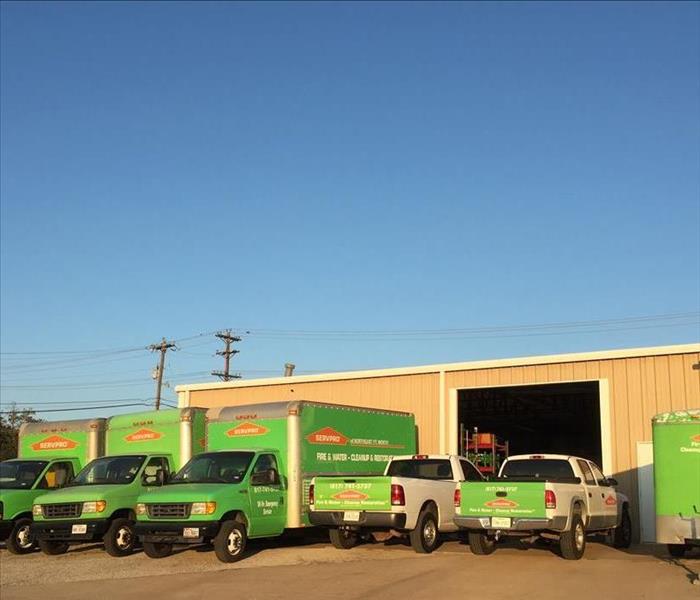 Storm and Disaster Relief for Fort Worth Property Owners Is Only a Phone Call Away to SERVPRO
Storm and Disaster Relief for Fort Worth Property Owners Is Only a Phone Call Away to SERVPRO
Storm Damage Cleanup and Restoration in Fort Worth and the Pros from SERVPRO
The thunderstorms in Fort Worth are known to be quite severe during this time of year. The excessive rains and high-speed winds created by a storm can cause costly flood damage to your property. If there is enough rain to cause water to get deep outside, then it can quickly enter your home. Your roof is one part of your building structure that is susceptible to various types of damage. If your roof gets broken somehow, it can cause flood damage inside the living area of your house.
Thunderstorms can also bring about hail and lightning that can hit your roof. Both of these elements can cause your home in Fort Worth to develop flood damage. Ice storms do happen, and they can tear apart your roof shingles. A lightning bolt can hit your house and cause much destruction.
If anything ever happens to your roof or your roof's shingles, it is possible for water to leak into your structure. If moisture gets into your home from above, much damage can result as the water works its way down to your floor. Roof damage can also create safety hazards and if not repaired can be the cause of water-related issues in the future. This link from the EPA provides disaster recovery information for many weather-related conditions that may arise during this time of the year.
When mitigating any storm-related problems, our SERVPRO technicians first make sure that the building is safe for all workers and occupants. Sometimes this requires removing pieces of the roof or ceiling that are hanging down and might fall. Other times we have to call in a certified contractor to fix electrical or plumbing issues.
After the work area is deemed safe, our SERVPRO crew determines the source of where the water is leaking into the home. We then figure out how to seal the hole in the roof so that no more moisture can enter the living area of the building. In some cases, we can permanently fix the leak in the roof, but in other cases, we temporarily fix it until a certified roofing contractor can conduct the repair or reconstruction.
Once water has stopped leaking into your house, we use specialized extraction and drying equipment to remove the moisture. If you ever have water-related problems after a rainstorm, call SERVPRO of Northeast Ft. Worth at (817) 741-5737 24 hours a day, seven days a week.
More about local parks and recreation by clicking
Why Flood Damage Severely impacts bedrooms in Fossil Creek
6/6/2018 (Permalink)
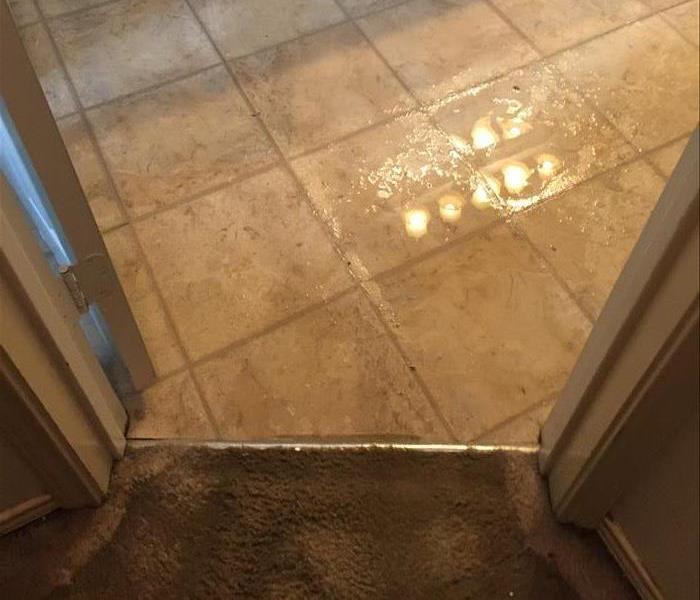 Water damage in this home affected multiple rooms.
Water damage in this home affected multiple rooms.
Common items affected by water damage in your home
Ground-floor bedrooms can be among the most heavily affected rooms in a home in Fossil Creek when flood damage hits. While sleeping areas on second floors may be safe from most of the effects of rampaging floodwaters, ground floor and basement bedrooms contain many amenities that may be more vulnerable to severe water damage than objects found in other parts of the home. SERVPRO excels in restoring materials without having to replace them whenever possible, but we still see some of our most challenging work cut out for us wherever bedrooms are concerned.
Bed Sets
Flood damage in Fossil Creek can cause costly damage to sheets, mattresses, pillows, and any other parts of a bed. For some homeowners, these items can represent a combined total of thousands of dollars in value. One of the primary things we do after arriving and ask many residents to do before we get there is to separate pillows, sheets, and other layers from each other. Keeping these items separated out early on helps them to dry out faster and prevents color bleed from taking place.
Carpeting
Most local homes fill their bedrooms with carpeting and rugs that can sustain severe damage in the event of a flood. Storm floods typically cause warping, discoloration, and material degradation in both the upper layers of carpeting and in the padding below them. Depending on the conditions, we may be able to replace sections of carpeting while keeping other areas intact selectively, but most floods force us to replace flooring in carpeted rooms entirely.
Valuable Belongings
Many valuable personal items are stored in the average bedroom, including electronics, clothing, objects of sentimental value, and a wide range of other possibilities. While some items may be lost forever after being inundated with water, others may yet be salvaged. We examine every damaged item individually to determine if and how we should attempt to clean and restore it.
SERVPRO of Northeast Ft. Worth helps local homeowners to recover from the effects of flood damage on a 24/7 basis. Call us at (817) 741-5737.
See local restaurants in Fossil Creek here.
What You Can Do When a Storm Floods the Office Space of Your Fort Worth Home
4/13/2018 (Permalink)
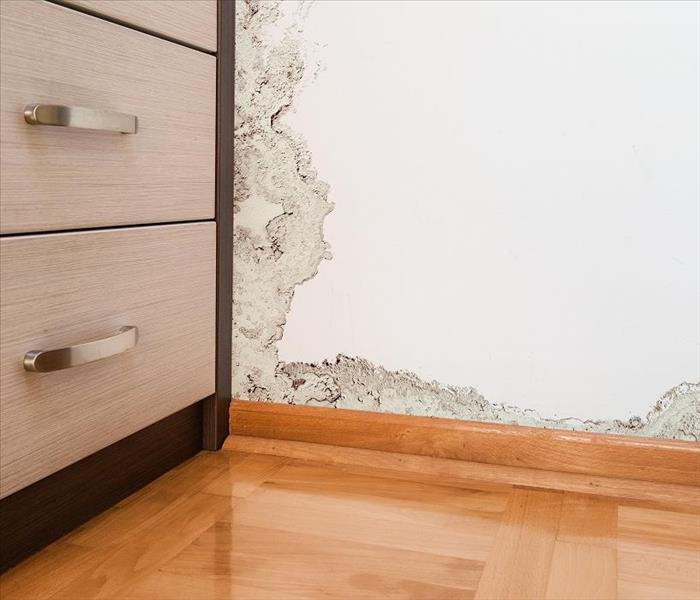 Flood damage in your home should be addressed as soon as possible because it can lead to mold growth and structural damage.
Flood damage in your home should be addressed as soon as possible because it can lead to mold growth and structural damage.
Call on SERVPRO if You Experience Flood Damage in Your Home
Heavy rainfall can cause flood damage, especially during a particularly severe storm. There are many ways that water can get inside of your Fort Worth home during a storm, but one of the most common is debris. A storm with high winds can cause rocks, tree branches, and even lawn chairs to break the windows of your home, allowing floodwaters to seep inside. When the waters seep into your basement office space, it can seem like an utter nightmare. Your computer is there along with all of the electrical wiring to make your electronics function. Luckily, professional help is nearby to get your office back to its pre-storm state quickly.
Damaging flood waters can seep into your Fort Worth home swiftly and soak into your belongings, such as the wood of your desk or the fibers of your carpet. Our technicians know how vital it is to respond to water damage as quickly as possible, as it worsens the longer it sits and can lead to mold growth. We strive to try and get to your home as soon as we possibly can after receiving your call so that we may begin the remediation process and remove the floodwaters causing damage.
SERVPRO can bring advanced tools like truck-operated pumps and powerful wet/dry vacuums to remove the water from your basement office space. We can use moisture meters to determine the level of moisture in the space and identify the most impacted areas. Afterward, we can employ the right tools to dry out your carpet, floors, the base of your walls, and the legs of your desk.
Floods can bring unsanitary water with them. SERVPRO can inspect and measure the safety of the water that has flooded your home. Should the water be toxic, we can rip up the carpets in your office and throw them out for you as they cannot be kept once contaminated. Afterward, SERVPRO can help you find a contractor to replace the carpeting in your office space. We strive to do whatever we can to return your home to its preloss stage.
When your home has been overrun with damaging floodwaters, do not wait. Call SERVPRO of Northeast Ft. Worth at (817) 741-5737. We can send our technicians to your home as soon as possible.
Click here for more information on the city of Fort Worth.
When A Storm Takes Your Keller Residence By Surprise
3/20/2018 (Permalink)
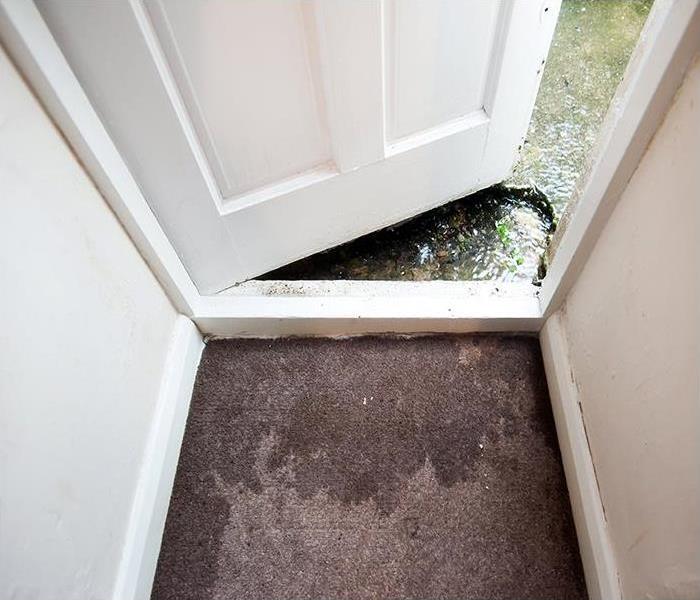 Storms are destructive and can easily flood your home with excess water.
Storms are destructive and can easily flood your home with excess water.
Storm Damage Repair And Restoration
An average rain shower can be pleasant to listen to as you fall asleep but when a massive storm hits your home and does severe damage, the water removal process can be anything but relaxing. Storms are destructive and can easily flood your home with excess water. Additionally, this water might not always be safe. Because the intense weather can flood hundreds of gallons of rainwater into your home, it is possible to end up with a mess that you just cannot clean up yourself. Fortunately, you do not have to.
When water has invaded and taken over your Keller residence, trust our IICRC-certified technicians to remove it from your property swiftly. We use powerful industrial grade wet/dry vacuums to remove all of the excess water so we can get your home back to the condition it was in before the storm hit. Upon calling our office, our technicians can be on the scene as soon as possible.
We can remove the excess water from your home, and once we do, we can move onto the drying process. SERVPRO understands how valuable your carpets are to you and know that a flood can soak them thoroughly and dirty them. Depending on the type of water that flooded your home, SERVPRO can determine if your carpets are salvageable and clean them entirely if they are. Underneath your carpets, we can focus on your floorboards. SERVPRO uses advanced equipment like dehumidifiers and air movers to eliminate harmful moisture in the air and dry out your belongings.
In rare cases, intensely contaminated black water can flood your home from the storm's influence. Should your house be flooded with unsafe water, we can guide you through what you can keep and what you should not. SERVPRO is with you every step of the way to make an inventory of your belongings and assist with your claims process.
When a storm hits your home, and it becomes flooded with excessive water, do not wait. Call SERVPRO of Northeast Ft. Worth area at (817) 741-5737 to remove it. 24/7, we are ready to take your call and return your home to its preloss condition.
Click here for more about Keller.
Water Removal, Cleaning, And Restoration Services Available In Ft Worth
2/20/2018 (Permalink)
 Flooding in Forth Worth? Call the Green Fleet from SERVPRO for Water Extraction and Cleanup
Flooding in Forth Worth? Call the Green Fleet from SERVPRO for Water Extraction and Cleanup
Flooding from Storms Needs Immediate Extraction--Call SERVPRO
Removing standing water after a storm needs to happen immediately after the event occurs. Calling a professional water removal company can have the right amount of personnel, equipment, and resources on your doorstep quickly enough to prevent saturation of critical areas of your Fort Worth home.
Reliable water removal services are available throughout the Fort Worth area. You obtain 24/7 emergency response service, a no-cost estimate of damages found on your property, and a highly trained team of professionals ready to ensure your water removal gets done right.
Extracting standing water and drying the entire structure of your home may sound like an easy task. However, since every situation is different, there is always the chance of something going wrong. You need a skilled team of IICRC-industry certified professionals that can adjust on the go, making changes needed to provide you with a successful restoration.
Leaving flood waters on your property for an extended amount of time can cause severe damage to the structural integrity of your home's support system, walls, ceiling, flooring, and insulation. Hesitating may also cause corrosion, and rot, leading to additional problems as time goes on, if mold has the opportunity to set in, restoring your home requires additional services.
SERVPRO's qualified technicians utilize a variety of water location and extraction equipment to ensure proper water removal on your property. Everything from hand-held portable units to truck-mounted water extractors, infrared moisture detectors, hygrometers, dehumidifiers, air-movers, and attachments make finding, removing, and drying the affected area easier.
SERVPRO crews are standing by to provide you with the services and technical knowledge necessary to return your home to a quality condition after heavy storms, rain, or flooding occurs in your home. Make the most of what is available in your area and give us a call, today.
SERVPRO of Northeast Ft. Worth offers quality solutions to residents in Fossil Creek, Keller, and Park Glen, as well as other surrounding communities. We are proud to serve, providing water removal, cleaning, and restoration services you can trust. (817) 741-5737
Local parks by clicking here.
We Drop Everything To Manage Flood Damage In Fort Worth
1/21/2018 (Permalink)
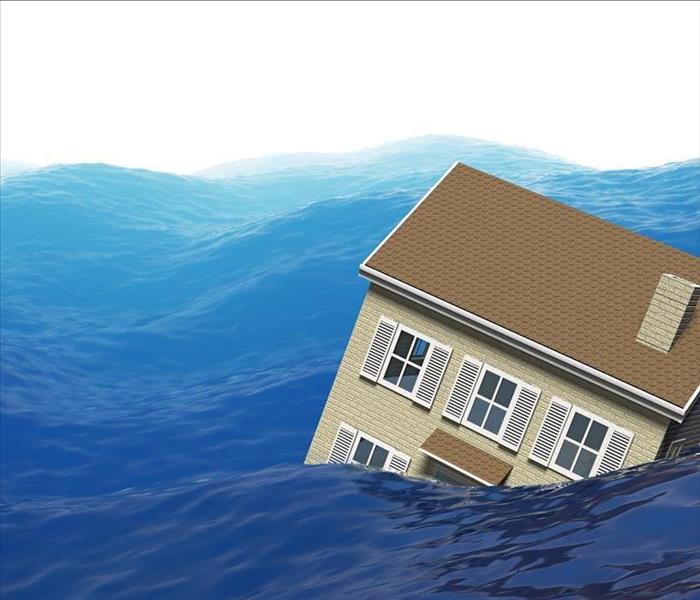 Flash Flooding Can Ruin Your Property in Fort Worth, Call SERVPRO for Help
Flash Flooding Can Ruin Your Property in Fort Worth, Call SERVPRO for Help
Stormwaters Are No Match for SERVPRO's Technicians and Equipment
Planning for flash flooding in Ft. Worth is hard. Its very definition indicates that it was unpredictable. Thunderstorms brew in our area, bringing relief in times of drought, but there is no way to shut the rain down when it transforms from welcome to a disaster. When water flows into the lower levels of your home, you need our help fast.
The Fort Worth area experienced flood damage during recent storms, and your house is on the list of affected properties. You feel overwhelmed, but a referral from a friend brought you together with our trained flood restoration team. We get immediately to work on the damage done to your foundation and crawl space because we understand just how devastating standing water can prove to be.
Our service vehicles are equipped with nearly every piece of equipment imaginable to remove water and begin drying out the area. We chose to operate this way so that no time is lost in arranging for the necessary tools. Gas powered pumps and truck mounted water extractors get the job done regardless of whether the power is out. Quickly responding to this kind of water loss is at the core of the services we provide, and our customers relax at least a bit when our big green SERVPRO trucks arrive. Flash flooding can be decisive and swift in destroying properties.
Even if a number of your neighbors also experience flood damage, you do not stand in line waiting for our assistance. We scale up our services in response to the crisis you and perhaps the rest of community experience. If needed, we tap into our nationwide network of other SERVPRO disaster response companies.
Delay in removing water and drying out structure and contents is not acceptable to us as it results in irreparable damage. Fast action means most building materials are still restorable and fixtures such as carpeting and cabinetry respond to the skills of our highly-trained technicians. SERVPRO employees inventory and pack out possessions and stage them in a dry area of your home or our facility. You review what items you desire restored through special techniques like freeze drying as our crews extract the water and position air movers and dehumidifiers to dry out the flooded area.
You need SERVPRO of Northeast Ft. Worth by your side when the floodwaters fill your foundation. Call (817) 741-5737 for immediate assistance 24 hours a day.
More information on "Where the West begins." CLICK
Flood Damage Detection and Restoration in Fort Worth After a Storm
9/12/2017 (Permalink)
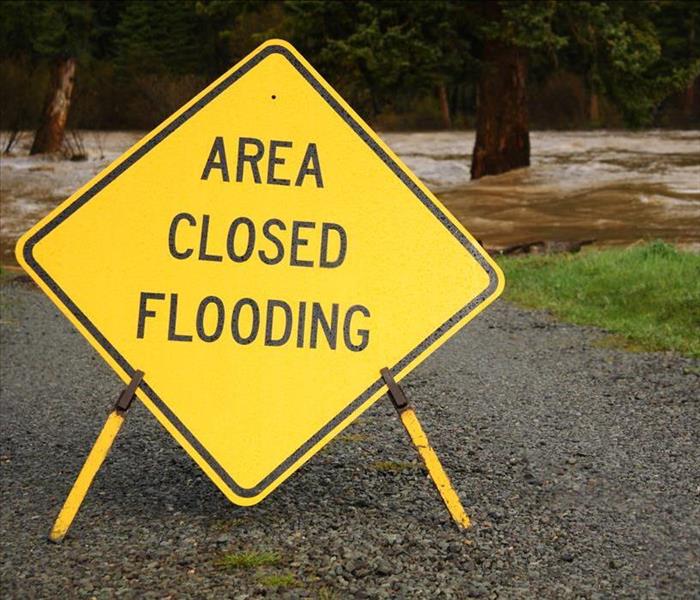 Fort Worth Flooded Homeowners Call on SERVPRO
Fort Worth Flooded Homeowners Call on SERVPRO
Fort Worth Properties, Soil Erosion, and Storm Damage
When the waters from a storm in Fort Worth recede, the owners of flooded homes begin assessing their property for what is salvageable. The damage can be tremendous. If factors such as poor construction, termites, and decay had already compromised the structural integrity of the house, the flood could be the last straw. From this end, it is important to act fast when a natural calamity such as a storm comes visiting.
If you are grappling with flood damage in Fort Worth after a storm, SERVPRO has highly trained disaster recovery teams to counter the impact. We follow IICRC recommendations to ensure a quick and efficient restoration process. Thanks to our advanced cleanup tools and products, we had managed to restore many homes to preloss conditions throughout the years - leaving them as neat as before, "Like it never even happened."
Houses that are built on concrete slabs where the soil is mostly clay are particularly vulnerable to flood damage. When clay is saturated, it expands unevenly and elevates parts of a slab, leading to cracks or breaks. Additionally, exterior walls can crack, embedded pipes may rupture, and the roof can sag. Everything gets worse when the soil dries and shrinks. In some cases, moving water may erode the ground from beneath and sweep a poorly-secured house off its foundation. It is advisable to evacuate the building if it has signs of cracks. Most cases are not this extreme, but always be aware of the condition of your foundation.
One of the first signs of flood damage is distorted frames on doors and windows, which prevents them from opening and closing. The glass may also twist and break when the house shifts, while excessive water may weaken interior drywall. Drywall that is soft, moldy, or crumbly should be replaced. SERVPRO technicians can remove walls and ceilings that sustained water damage in the process, and then clean and dry the insides to prevent mold growth. Demolition is done only when needed.
Most homes use insulation made of foams or fiber. This type of insulation tends to hold water and should be replaced after flood damage. If your home has closed-cell foam or similar type of insulation, it may absorb water and survive the flood. Most types of structural sheathing are also susceptible to flood damage because they are made of porous materials such as wood chips. When these materials absorb water, they swell and lose their strength. In this case, we may have to remove and replace them with new sheathing as well.
Recovering from flood damage after a storm can be challenging. During this time of distress, you can rely on SERVPRO of Northeast Ft. Worth to restore your property. As a part of your community, we understand that a natural disaster in this area can be devastating. For urgent or emergencies conditions call us at (817) 741-5737.
More about this city here.
Facing Fort Worth Flood Damage
7/22/2017 (Permalink)
 Storm Water Removal and Restoration in Fort Worth? Call SERVPRO
Storm Water Removal and Restoration in Fort Worth? Call SERVPRO
Your Home Gets Full Restoration from SERVPRO Post Storm Damage
The humidity and high temperatures of a North Texas summer fuel the energy of some intense storms. These storms drop heavy rains and sometimes hail mixed with strong winds. Torrential showers fill up the lowest levels of homes on slabs, basements, and crawlspaces, a challenge SERVPRO is always ready to overcome for our clients.
Over the period of a few hours, forceful winds and steady downpours make it clear you need professional help to restore the flood damage to your Fort Worth home. Your house has a slab on grade foundation, so the flood waters affect living areas, not just storage or mechanical spaces. We devise a plan to rid your structure of standing water and then dry out the contents, our focus on returning your dwelling to preloss condition.
Your concrete sub floor does hold moisture after the flood waters are pumped out and extracted. The water crept up the walls, its gypsum board, and wooden supporting structure also absorbing moisture. Air movers and dehumidifiers operate continuously to reduce the dampness. Experienced SERVPRO project managers work with technicians on your site to determine the drying targets for these materials based on industry standards. A baseline moisture level is measured, and then the various materials are rechecked throughout the drying process until the target is reached.
If carpeting is present, trained technicians use powerful vacuum extractors dry this floor covering in place. Usually, we remove and replace the padding to avoid re-saturating the carpet and because the pad is hard to dry and retains contaminants. SERVPRO workers take moisture levels and examine laminate, tile, and hardwood floors, to ensure we remove any water trapped beneath. This may require the use of drying mats or creative methods to raise the floors a bit to direct the flow from air movers beneath. Loosening and lifting sections of planks or tiles allow access, and drilling small holes through glossy finishes helps release water.
Throughout the restoration, care is taken to clean contaminants from surfaces and sanitize areas with professional products. During the work phase caution is the key, making sure no electrical shorts threaten the safety of the residents or the SERVPRO team. Occasionally reptiles, insects, and animals take shelter in a flooded home after a storm. When we release your restored home back to you, all flood damage will be remediated and any unwanted visitors evicted.
SERVPRO of Northeast Ft. Worth is certified and licensed to transform your flood damaged property back to a cozy and comfortable home. Call (817) 741-5737 as soon as you see the flood waters rise because every moment is critical during flood restoration.
Welcome to Fort Worth, click here.
Tornado Safety in Keller Texas
4/27/2017 (Permalink)
 When tornadoes occur it is better to be prepared.
When tornadoes occur it is better to be prepared.
Tornadoes are one of the most feared because their strong winds can cause devastating damage to entire towns. Tornado winds can exceed speeds of 100 miles per hour and this can easily damage homes and businesses as well as uproot trees and toss cars around like they are a toy. Since it is possible for a tornado to form anywhere in the U.S., it is important to look for the warning signs of the impending storm so you can get to a safe location.
The Difference Between A Tornado Watch And Tornado Warning
Your local news will usually put out a tornado watch or warning. If your area is under watch, this means that your area is experiencing conditions that make it possible for a tornado to form. You should be on alert if a tornado watch has been having been issued in the event the situation becomes more dangerous. When a tornado warning has been issued, this means there has been a tornado sighted and you need to take shelter immediately.
Tornado Warning Signs
There are several things you can look for when you know there is a threat of a tornado. Early warning signs are increasing winds, clouds moving rapidly, and the sky and clouds look green. Hail is another early warning sign of a tornado and what causes the sky to look the greenish color.
Tornado Preparedness
Knowledge is key to tornado preparedness. Make sure everyone in your family knows the signs of an approaching tornado and they know what to do.
During a storm listen to your local news or a weather radio station for updates. Also one can check out the National Oceanic and Atmospheric Administration at http://www.noaa.gov/ You can also install a weather app on your smart phone that will send you updates.
Also, you should consider confining pets to a carrier or placing dogs on a leash during a tornado watch so that you can transfer them to a safe room in case the warning is issued.
Even the most extensive preparation cannot prevent a tornado from causing significant damage to your home. If this happens it is important to call a storm damage restoration professional immediately to assist you in recovering.
For help please call us at :
SERVPRO Northeast Fort Worth
817-741-5737
www.SERVPROnortheastftworth.com
Storm Damage help in Fort Worth Texas
4/13/2017 (Permalink)
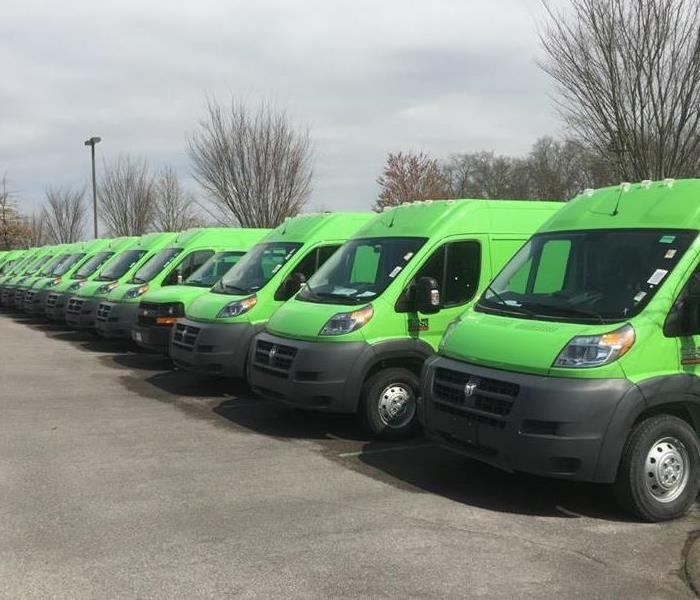 SERVPRO restoration vans ready to go.
SERVPRO restoration vans ready to go.
SERVPRO of Northeast Fort Worth specializes in storm and flood damage restoration. Our crews are highly trained and we use specialized equipment to restore your property to its pre-storm condition.
Faster Response
Since we are locally owned and operated, we are able to respond quicker with the right resources, which is extremely important. A fast response lessens the damage, limits further damage, and reduces the restoration cost.
Resources to Handle Floods and Storms
When storms hit the DFW Metroplex area we can scale our resources to handle a large storm or flooding disaster. We can access equipment and personnel from a network of 1,650 Franchises across the country and elite Disaster Recovery Teams that are strategically located throughout the United States.
Have Storm or Flood Damage? Call Us Today at 817-741-5737
Spring Flood Damage in Fort Worth
4/13/2017 (Permalink)
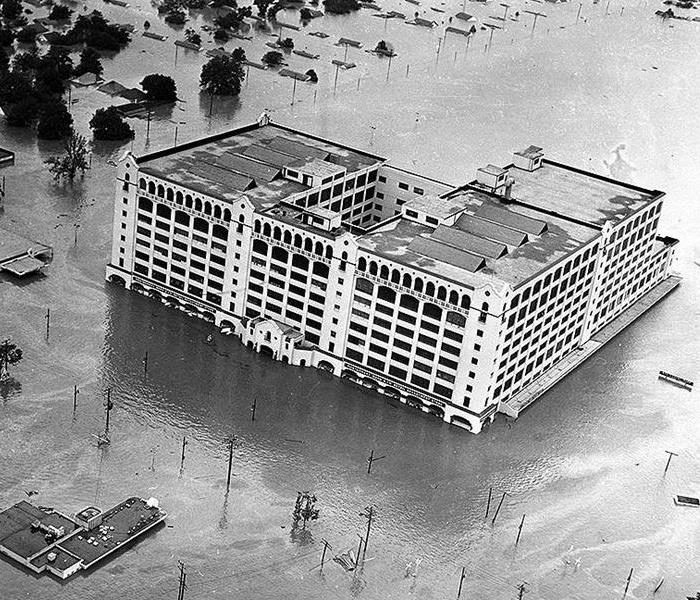 Flooding from the Trinity in an historic photo from the 1950's of the West 7th area.
Flooding from the Trinity in an historic photo from the 1950's of the West 7th area.
According to the National Flood Insurance program flooding is the most common natural disaster in the United States causing $2.7 billion in losses between 2001 and 2010. Flooding is not covered by most homeowner’s insurance policies so it may be necessary to buy a separate flood policy for your home.
Here are a couple of tips to keep water from entering your home during a heavy rain event:
1. Fix foundation leaks that may allow water to enter your home.
2. Make sure your roof is secure and protected.
3. Clear gutters and drains
If water ever floods your home, getting someone on site as soon as possible is key to keeping the amount of damage to a minimum. SERVPRO of Northeast Fort Worth is ready to respond at any time and also provides a free assessment and estimate.
Call us today at 817-741-5737 or look us up on the web www.SERVPROnortheastftworth.com
Like us on Facebook at
https://www.facebook.com/SERVPRO10638/
Flood Water tips for your Keller or Fort Worth Home
3/15/2017 (Permalink)
 Flooding can occur quickly so be prepared.
Flooding can occur quickly so be prepared.
How to respond to flooding:
Before the storm –
- Check your gutters, and clear out any debris that may be clogging them. Also assess your area for storm drains in low lying areas, and make sure those are clear as well.
- Remove fallen leaves and other debris from your yard.
- If you are in a flood zone, keep sandbags on hand and put up valuables.
- Check your insurance to see if you are covered for floods.
- Figure out the safest route from business to home. If your home is located in a flood zone, make a plan so that all family members understand were the closest safe ground is and how to get there.
- Ensure a plan is in place for family pets, as well.
- Make a list of valuables that you can keep in a safe place.
- Put together some supplies, such as food, water, a first aid kit, and medications together in a safe area in case they are needed. Also include flashlights, batteries, and a radio if possible.
- Fill up your gas tank in your car.
During the storm –
- Monitor the TV and radio for weather updates. If an evacuation is advised, evacuate quickly and safely. A good source is http://www.weather.gov/
- If water enters your home, evacuate to a higher ground even if there is no evacuation order in place by officials.
- If traveling, watch for washed out roads and downed power lines. Turn around, don’t drown!
After the flood –
- Make sure your drinking water is clean to prevent illness. Boil water for three to five minutes and then let cool before drinking. Alternatively, purchase bottled water from the grocery store.
- Check your home for moisture on the walls, carpets, and furniture. Dampness can cause mold and mildew. Open windows and turn on your heater to approximately 15 degrees higher than the outside temperature to facilitate drying.
- Practice good hygiene such as hand washing to help prevent illnesses.
- Call SERVPRO of Northeast Fort Worth to help with storm and flood damage at
- 817-741-5737
- our website is http://www.SERVPROnortheastftworth.com/
- Also check with FEMA for helpful information as well https://www.fema.gov/





 24/7 Emergency Service
24/7 Emergency Service
